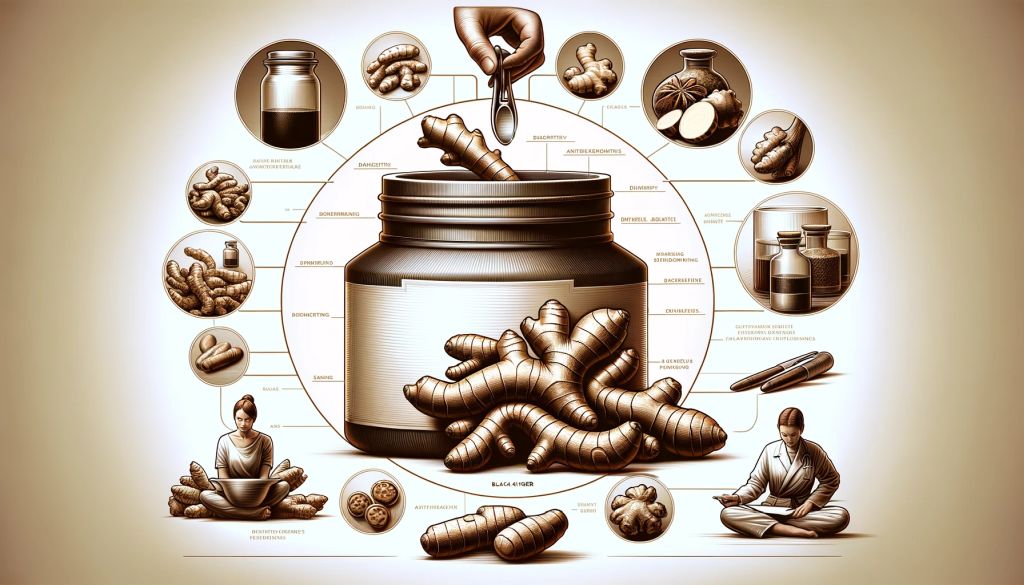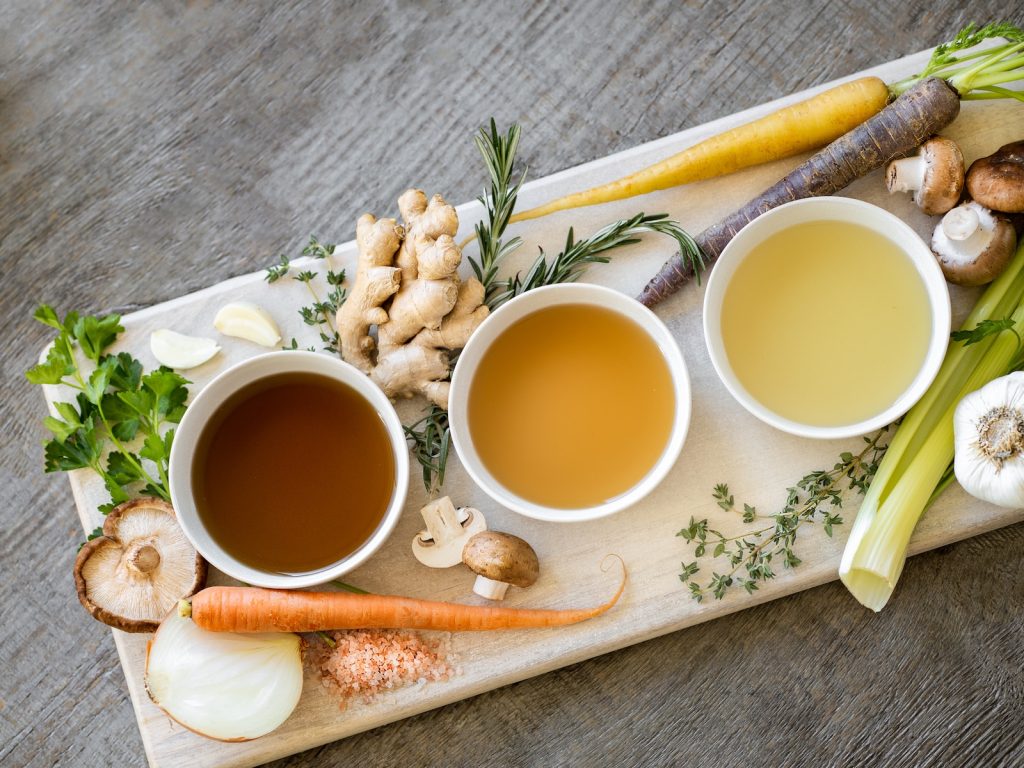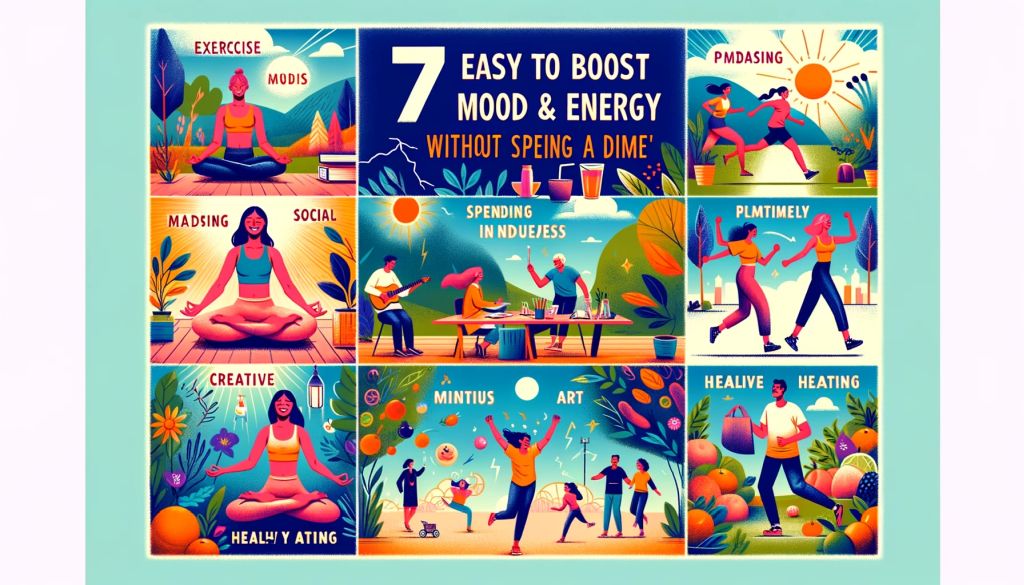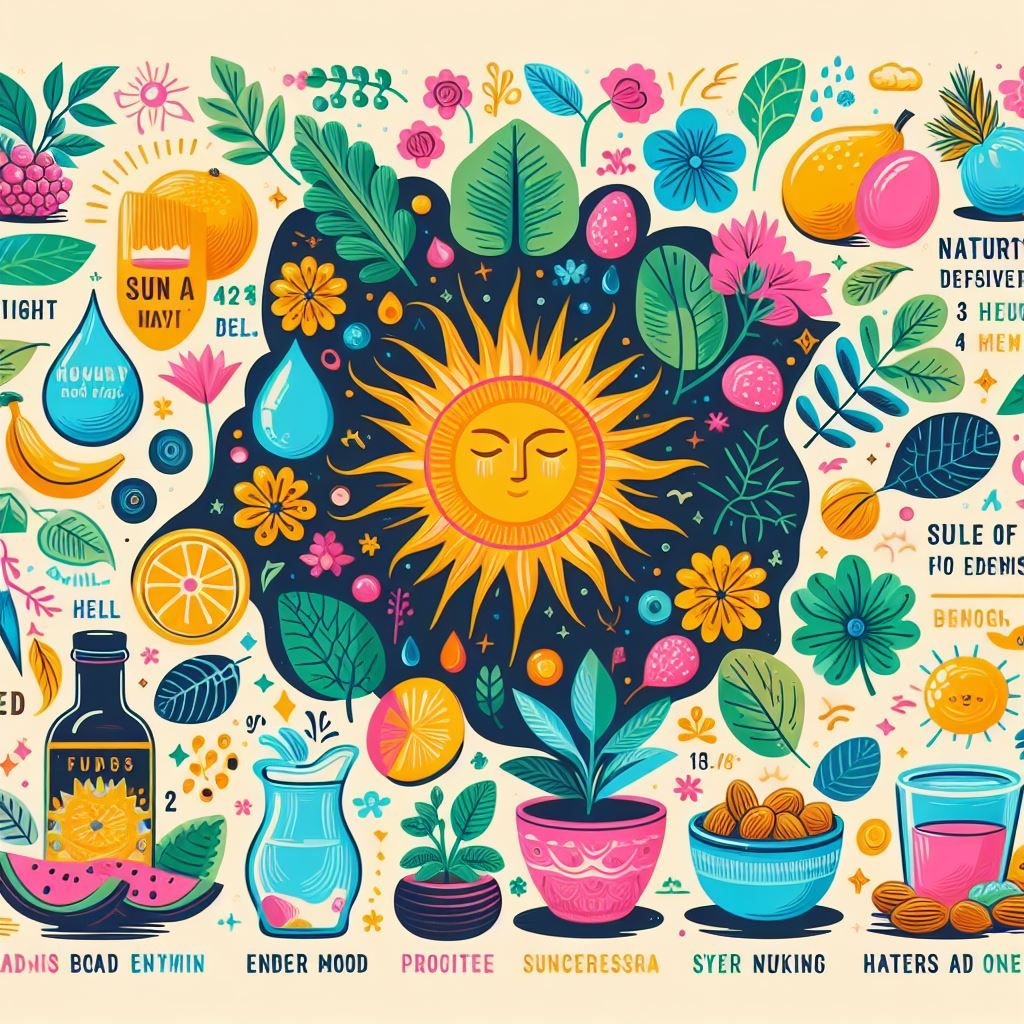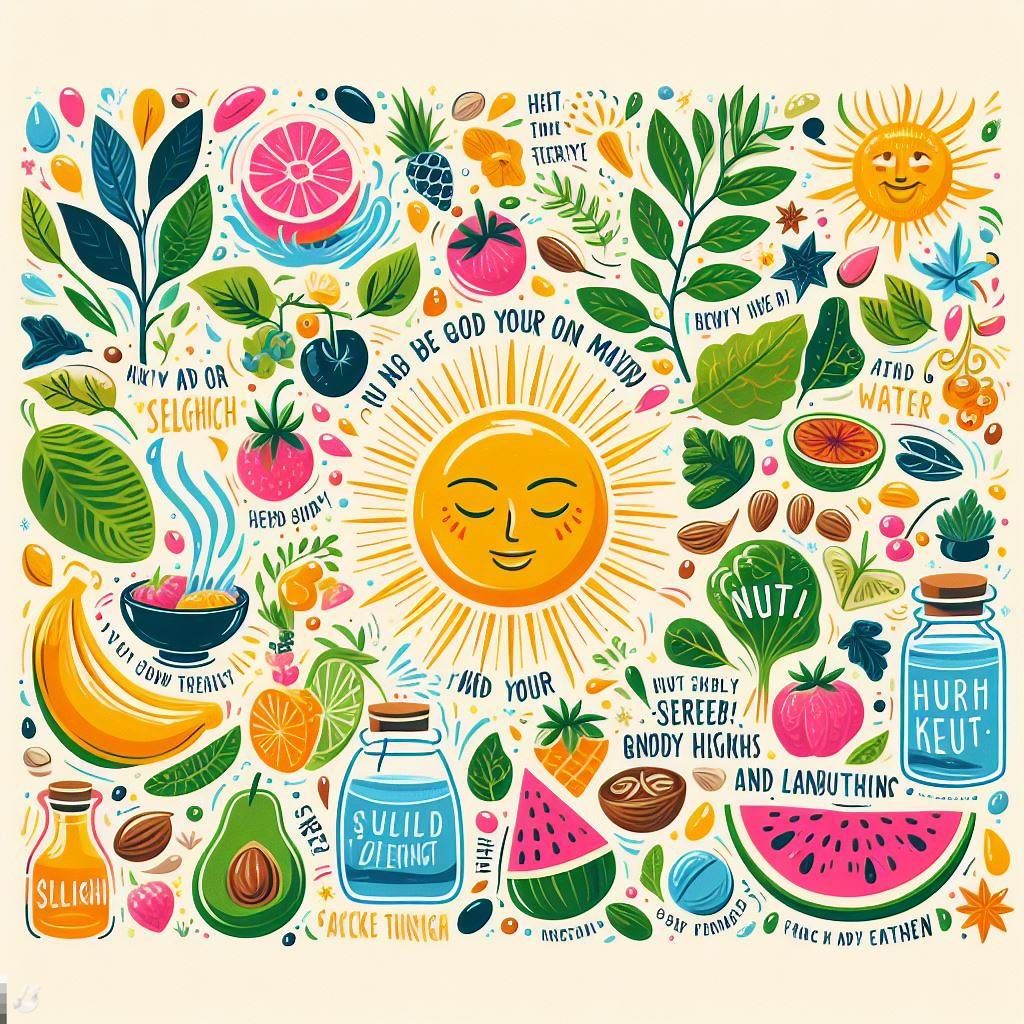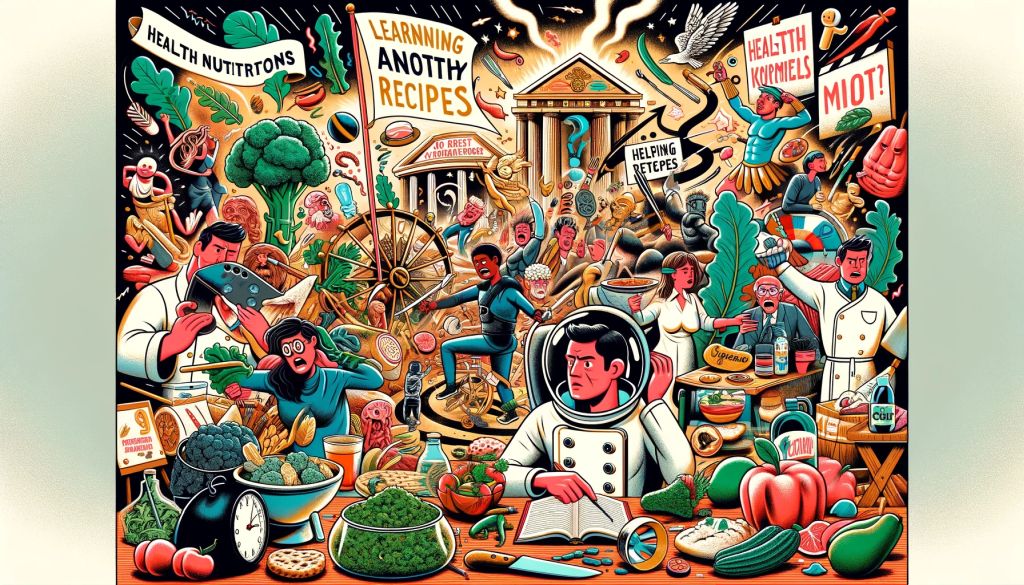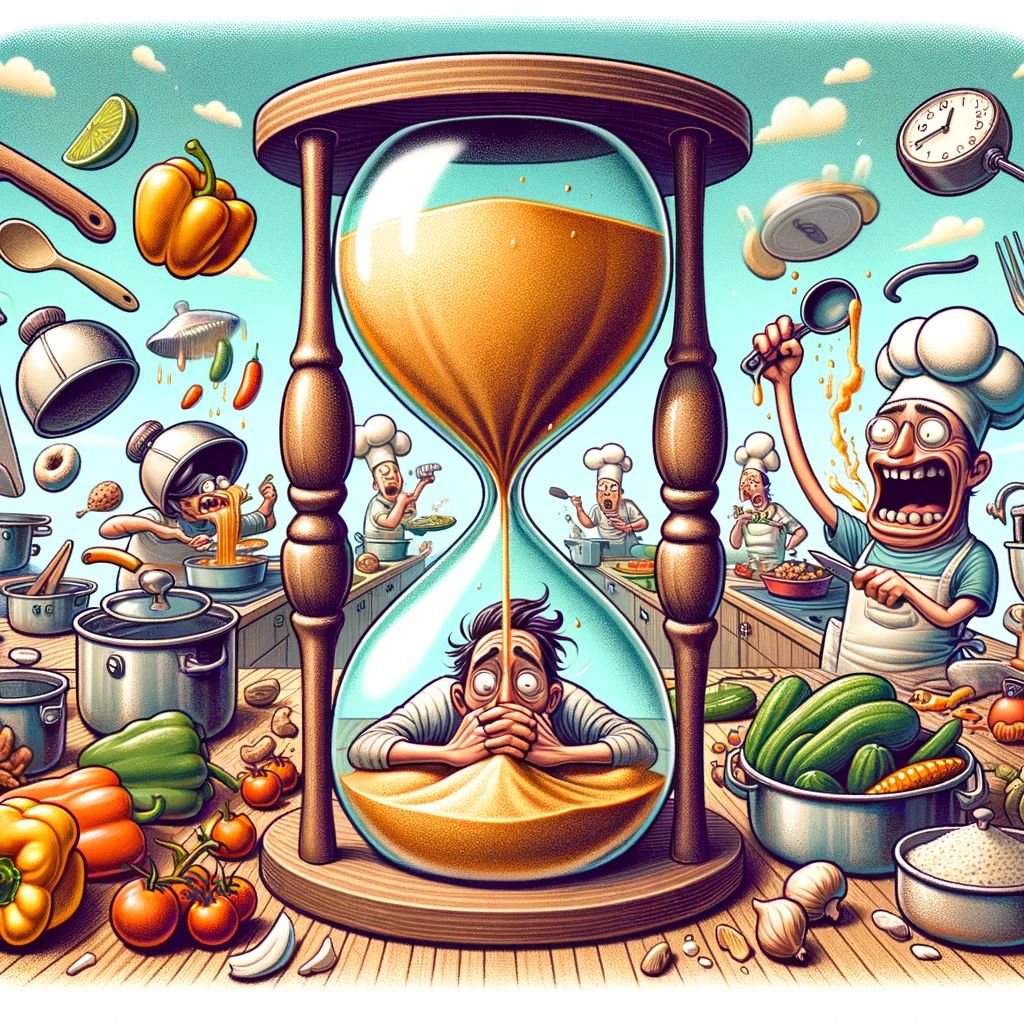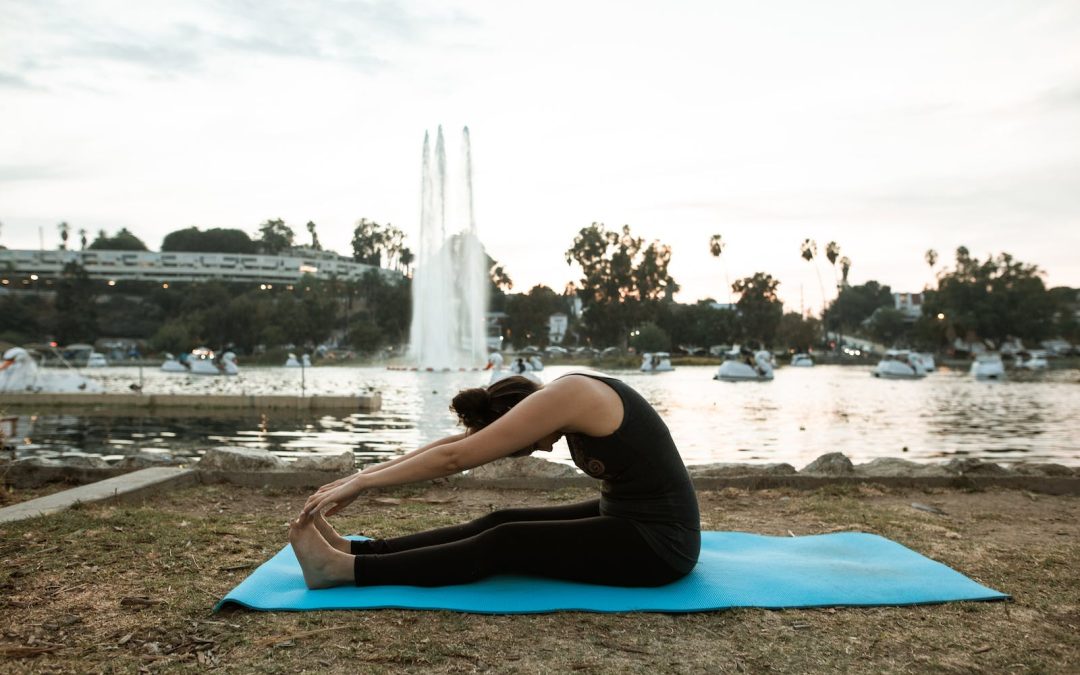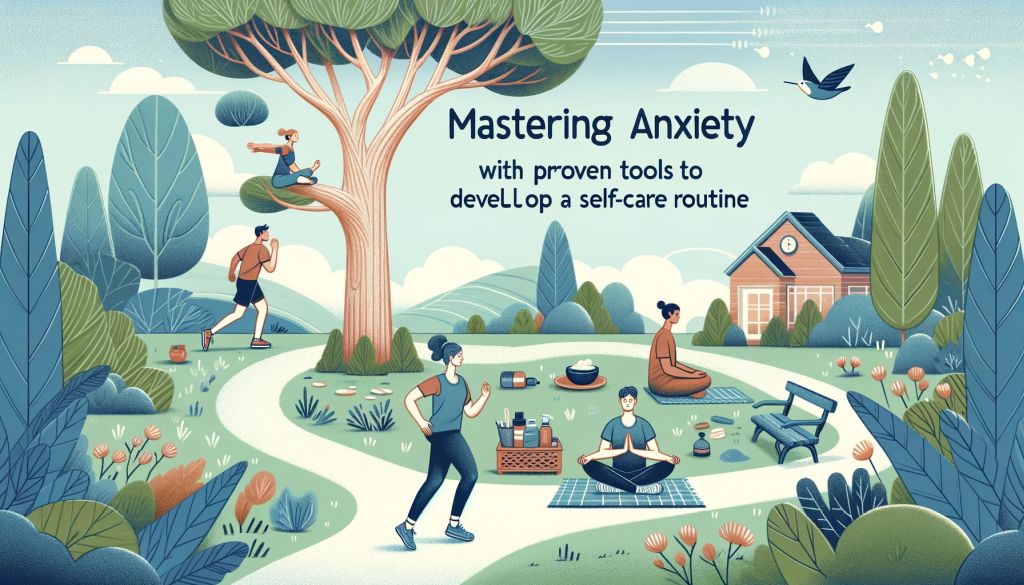
by Health And Healing AI | Jan 11, 2024 | Health
Menopause Made Easy: How Food Can Help You Feel Better

Cheerful-cooking-balanced-diet-kitchen
What to Eat When Menopause Strikes: I’m Elizabeth Redd, the news curator for Health and Healing AI. Today, I want to share a fantastic article from Healthline that will help you cope with menopause symptoms through Food.
How to Eat Your Way Out of Menopause Misery
What to Eat When Menopause Strikes: This article is a must-read for anyone going through Menopause or who knows someone who is going through it.
It offers a comprehensive and easy-to-follow meal plan that covers breakfast, lunch, dinner, and snacks for two weeks.
The recipes are delicious, nutritious, and designed to support your hormonal balance, mood, energy, and overall health.
I loved this article because it shows how Food can be a powerful ally in managing Menopause.
It also gives practical tips on shopping, cooking, and eating mindfully during this challenging time.
Plus, it has some mouth-watering photos that make you want to try every dish.
If you’re looking for a way to ease your menopause symptoms and enjoy your Food, this article is for you. Check it out and let me know what you think. Bon appétit! 🥂
Main Points

A serene setting with a healthy meal for menopausal women. Photo by Field Cottage
Menopause and its symptoms – What to Eat When Menopause Strikes
- Menopause is the natural transition in a woman’s life when her ovaries stop producing eggs and hormones.
- It usually occurs between the ages of 45 and 55 but can vary depending on genetics, lifestyle, and health conditions.
- Menopause can cause various physical and emotional symptoms, such as hot flashes, night sweats, mood swings, insomnia, weight gain, vaginal dryness, and reduced libido.
- These symptoms can affect a woman’s quality of life, self-esteem, and relationships.
How Food can help with Menopause
- Food can play a crucial role in managing menopause symptoms and preventing aging-associated diseases, such as osteoporosis, heart disease, and diabetes.
- Certain foods can help balance hormones, regulate body temperature, boost mood, support bone health, and lower inflammation.
- Some beneficial foods for Menopause are soy, flaxseeds, nuts, seeds, fruits, vegetables, whole grains, legumes, fish, eggs, dairy, and herbs.
- On the other hand, some foods can worsen menopause symptoms and increase health risks. These include processed foods, refined sugars, caffeine, alcohol, spicy foods, and red meat.
The 14-day menopause meal plan
- The article provides a 14-day menopause meal plan that covers each day’s breakfast, lunch, dinner, and snacks.
- The meal plan is based on the Mediterranean diet, rich in plant-based foods, healthy fats, lean proteins, and moderate amounts of dairy.
- The meal plan is flexible and can be adapted to personal preferences, allergies, and intolerances.
- The meal plan aims to provide around 1,600 calories per day, which can be adjusted depending on individual needs and goals.
- The meal plan also includes tips on shopping, cooking, and eating mindfully during Menopause.
The Mediterranean Diet

A colorful plate of fresh vegetables for menopause meal planning. Photo by Dan Gold
What to Eat When Menopause Strikes: The Mediterranean diet is a way of eating inspired by the traditional foods and cooking methods of the countries bordering the Mediterranean Sea, such as Greece, Italy, Spain, and France.
It is rich in plant-based foods, such as fruits, vegetables, nuts, seeds, legumes, whole grains, and olive oil, and includes moderate amounts of fish, seafood, poultry, eggs, dairy, and red wine.
It limits or avoids red meat, processed foods, added sugars, and other unhealthy fats.
The Mediterranean diet is not only delicious but also beneficial for your health.
It may help you lose weight, lower your cholesterol and blood pressure, prevent diabetes, and protect your heart and brain123456
If you want to try the Mediterranean diet, you can start by following some simple steps, such as:
- Eat more fruits and vegetables every day. Aim for at least five servings of different colors and varieties.
- Switch to whole grains instead of refined grains. Choose whole-grain bread, pasta, rice, couscous, quinoa, oats, and other cereals.
- Use olive oil as your primary source of fat. Drizzle it on salads, vegetables, bread, and cooked dishes. Avoid butter, margarine, and other oils high in saturated or trans fats.
- Eat fish and seafood at least twice a week. Salmon, tuna, sardines, mackerel, and other oily fish are excellent sources of omega-3 fatty acids, which are suitable for your heart and brain.
- Include nuts, seeds, and legumes in your diet. They are high in protein, fiber, and healthy fats. You can snack on them, add them to salads, soups, and stews, or make dips and spreads.
- Enjoy moderate amounts of dairy products, such as cheese, yogurt, and milk. Choose low-fat or fat-free versions when possible.
- Limit your intake of red meat, processed meat, and sweets. These foods are high in calories, saturated fat, sodium, and sugar and can increase your risk of chronic diseases. Have them only occasionally or in small portions.
- Drink water as your primary beverage. Stay hydrated throughout the day with plain water, sparkling water, or herbal teas. Avoid sugary drinks, such as soda, juice, and sports drinks.
- If you drink alcohol, do so in moderation. The Mediterranean diet allows for a small amount of red wine, which may have some health benefits. However, drinking too much alcohol can harm your health. Limit yourself to one glass per day for women and two for men.
- Enjoy your Food with others. The Mediterranean diet is about what you eat and how you eat. Share your meals with family and friends without distractions from screens and devices. Savor the flavors, aromas, and textures of your Food. Eat slowly and mindfully, and stop when you are full.
If you want to learn more about the Mediterranean diet, you can check out these resources:
Mediterranean Diet 101: Meal Plan, Foods List, and Tips, Mediterranean diet for heart health, Guide to the Mediterranean diet, and What is the Mediterranean Diet?
My Biggest Takeaway

Skillful-chef-arranging-healthy-ingredients.
What to Eat When Menopause StrikesThe biggest takeaway from this article is that Menopause doesn’t have to be a miserable experience.
You can ease your symptoms and improve your health and well-being with the right food choices.
The 14-day menopause meal plan is a great way to start your journey of eating well during Menopause.
It will help you enjoy delicious and nutritious meals that support your hormonal balance, mood, energy, and overall health.
During this challenging time, you will also learn how to shop, cook, and eat mindfully.
By following this meal plan, you will feel better and discover new flavors and cuisines that will make your taste buds happy.
Related Articles From Around The Internet

Nourish Your Way Through Menopause with This 14-Day Plan. Photo by Tim Douglas
What to Eat When Menopause Strikes: If you want to learn more about Menopause and how to eat well during this phase of life, you can check out these articles from around the internet:
5-Day Menopause Meal Plan with Recipes & Shopping Lists – Diet Doctor
This article provides a free five-day menopause meal plan based on the keto or low-carb diet.
It explains how this diet can help you lose weight, reduce hunger, and improve your menopause symptoms.
It also gives you tips on avoiding the keto flu and creating your keto diet plan. You can find delicious and easy recipes for breakfast, lunch, and dinner, as well as a shopping list for each day1
Menopause Diet: How What You Eat Affects Your Symptoms – Healthline
This article gives you an overview of how your diet can affect your menopause symptoms and your health.
It tells you what foods to eat, what foods to avoid during Menopause, and why.
It also provides some general guidelines on eating a balanced and varied diet that meets your nutritional needs.
You can learn about the benefits of dairy products, healthy fats, whole grains, fruits, vegetables, phytoestrogens, and protein for menopause2
7-Day Menopause Diet Meal Plan (PDF & Menu) – Medmunch
This article offers a comprehensive guide to following a diet for Menopause, including a sample 7-day plan featuring daily meals and a corresponding shopping list.
It explains the science behind the diet and how it can help you manage your weight, hormones, and health.
It also gives you tips on customizing the diet to suit your preferences and goals.
You can download the PDF version of the plan and the menu for free3
Related Books About Menopause You May Be Interested In

A bowl of oatmeal with blueberries, almonds, and honey. Photo by Karolina Grabowska
The Galveston Diet: The Doctor-Developed, Patient-Proven Plan to Burn Fat and Tame Your Hormonal Symptoms
This book by Dr. Mary Claire Haver explains how to follow the Galveston Diet, a low-carb, anti-inflammatory, and intermittent fasting plan that can help you lose weight, balance your hormones, and reduce your menopause symptoms.
Check this book out on Amazon.
The Menopause Manifesto: Own Your Health with Facts and Feminism
This book by Dr. Jen Gunter, the author of The Vagina Bible, empowers you with evidence-based information and advice on how to navigate Menopause with confidence and dignity.
It covers topics such as hormone therapy, sexual health, bone health, mental health, and more. Check this book out on Amazon.
Hormone Repair Manual: Every Woman’s Guide to Healthy Hormones After 40
This book by Dr. Lara Briden, the author of Period Repair Manual, offers natural and effective solutions for common hormone problems after 40, such as perimenopause, Menopause, insomnia, weight gain, mood swings, and more.
It also explains how to optimize your health and prevent chronic diseases. Check this book out on Amazon.
The Menopause Reset: Get Rid of Your Symptoms and Feel Like Your Younger Self Again
This book by Dr. Mindy Pelz reveals how to reset your hormones, detox your body, and reclaim your energy and vitality during Menopause.
It teaches you how to use intermittent fasting, keto, and other strategies to achieve optimal health and wellness. Check this book out on Amazon.
Next Level: Your Guide to Kicking Ass, Feeling Great, and Crushing Goals Through Menopause and Beyond
This book by Dr. Stacy Sims, the author of ROAR, shows you how to take your fitness, performance, and health to the next level during Menopause and beyond.
It provides practical and science-based guidance on training, eating, and living better as an active woman. Check this book out on Amazon.
This website participates in the Amazon Services LLC Associates Program, an affiliate advertising program designed to provide a means for sites to earn advertising fees by advertising and linking to Amazon.com and affiliated sites.
Wrap UP

A glass of refreshing water to stay hydrated during menopause. Photo by Ánh Đặng
What to Eat When Menopause Strikes: Menopause is a natural transition that affects every woman differently. Some may experience unpleasant symptoms such as hot flashes, mood swings, insomnia, and weight gain.
Others may breeze through this phase with minimal discomfort.
Whatever your experience, eating a balanced and nutritious diet can help you cope with the changes and support your overall health and well-being.
The 14-day meal plan presented in this article is designed to provide you with foods rich in phytoestrogens, antioxidants, fiber, calcium, and other essential nutrients.
These foods can help balance your hormones, reduce inflammation, protect your bones, and prevent chronic diseases.
You can customize the plan according to your preferences, allergies, and dietary restrictions.
Remember to drink plenty of water, limit alcohol and caffeine, and consult your doctor before significantly changing your diet.

by Health And Healing AI | Jan 3, 2024 | Health, Wellness
Reveal the Powerful effects of Black Ginger on Health and why it’s a game-changer.

Sophisticated depiction of various black ginger products and their positive impact on health and wellness.
I remember the day I stumbled upon black ginger. It wasn’t just another root in the market but a revelation.
As someone who struggled with chronic fatigue, this was a game-changer. I started adding it to my tea, and within weeks, I felt a surge of energy.
It wasn’t just a fleeting boost; it was transformative. Today, I will share how this potent root can revolutionize your health, from boosting energy to combating inflammation.
Discover the path to a revitalized you, starting with a simple addition to your daily routine.
Black ginger, also known as Kaempferia parviflora, is a herbaceous plant traditionally used in Southeast Asian medicine for its therapeutic properties.
It belongs to the ginger family and has a distinct black or dark brown color, which sets it apart from other ginger varieties.

Unlocking the Health Wonders of Black Ginger – A Closer Look,
This plant is rich in compounds that have been shown to exhibit excellent antioxidant, anti-inflammatory, anti-diabetic, and anti-obesity effects.
Recent studies have examined the potential health benefits of black ginger, and the results have been promising.
This article will explore the many health benefits of black ginger and how it can improve your overall well-being.
From its ability to promote circulation to its potential to boost brain function, you will discover why this herb is gaining popularity in the health and wellness community.
So, let’s dive in and explore the excellent health benefits of black ginger.
Black ginger, known as Kaempferia parviflora or Thai black ginger, offers several potential health benefits.
It has been linked to improved physical fitness performance, muscular endurance, and reduced fatigue by improving inflammation and energy metabolism PMC – NCBI (https://www.ncbi.nlm.nih.gov/pmc/articles/PMC4946221/).
Additionally, black ginger is rich in amino acids, selenium, and antioxidants such as tannins, anthocyanins, and flavonoids, which contribute to its potential health benefits BuyNatural (https://buynatural.com.au/magazine/health-magazine/the-secret-healing-powers-of-black-ginger-unlocking-a-treasure-trove-of-health-benefits/).
Furthermore, it has been associated with improved energy, lower fatigue, enhanced glucose metabolism, and antioxidant properties Ujido (https://ujido.com/blogs/matcha-insider/9-powerful-health-benefits-of-black-ginger).
Historical and Traditional Uses

Exploring the Unknown – The Unique Properties of Black Ginger.
Black ginger has a rich history of use in traditional medicine and culinary practices.
In Thailand, black ginger is known as “Krachaidam” and has been used for centuries to treat various ailments.
Traditional Medicine

Depiction of black ginger’s anti-inflammatory benefits in traditional remedies.
In traditional medicine, black ginger is believed to have numerous health benefits.
It is commonly used to treat digestive issues such as bloating, gas, and indigestion.
It is also believed to have anti-inflammatory properties and can be used to alleviate pain and swelling.
Some studies have even suggested that black ginger may have anticancer properties.
Culinary Uses
Black ginger is also a popular spice in Thai cuisine. It is commonly used to flavor soups, curries, and stir-fries.
It has a slightly sweet and spicy flavor that pairs well with other traditional Thai ingredients, such as lemongrass, galangal, and kaffir lime leaves.
In addition to its culinary uses, black ginger is also used to make a popular Thai herbal drink called “Krachaidam tea.”
This tea is believed to have numerous health benefits and is commonly consumed after meals to aid digestion.
Overall, black ginger has a long history of use in traditional medicine and culinary practices in Thailand.
While more research is needed to understand its health benefits entirely, it is clear that black ginger has a unique flavor and potential health benefits that make it a valuable addition to any diet.
Active Compounds and Antioxidant Properties

Unlocking Wellness – The Undiscovered Health Potentials of Black Ginger. Photo by Bluebird Provisions
Black ginger is a unique herb that is rich in bioactive compounds. These compounds are responsible for the herb’s therapeutic properties.
The bioactive compounds present in black ginger include flavonoids, gingerol, and other antioxidants.
These compounds have potent antioxidant effects that protect the body from free radicals and oxidative stress.
Bioactive Compounds
Black ginger contains several bioactive compounds that contribute to its therapeutic properties. One of the most important bioactive compounds found in black ginger is gingerol.
Gingerol is a potent antioxidant shown to have anti-inflammatory and anticancer properties.
It is also known to have beneficial effects on cardiovascular health and can help to lower blood pressure.
In addition to gingerol, black ginger contains several other bioactive compounds, such as flavonoids.
Flavonoids are a group of compounds that have potent antioxidant effects and are known to have anti-inflammatory properties.
They also benefit cardiovascular health and help lower heart disease risk.
Antioxidant Effects
The antioxidant effects of black ginger are due to the presence of several bioactive compounds, such as gingerol and flavonoids.
These compounds have potent antioxidant effects that protect the body from free radicals and oxidative stress.
Free radicals are unstable molecules that can cause damage to cells and tissues in the body.
They are produced due to normal metabolic processes and exposure to environmental toxins such as pollution and cigarette smoke.
Antioxidants such as those found in black ginger help neutralize toxins and prevent them from causing damage to cells and tissues.
In addition to their antioxidant effects, the bioactive compounds found in black ginger are also known to have anti-inflammatory properties.
Inflammation is a natural response of the body to injury or infection.
However, chronic inflammation can lead to a variety of health problems, such as heart disease, diabetes, and cancer.
The anti-inflammatory properties of black ginger can help to reduce inflammation in the body and lower the risk of these health problems.
In conclusion, black ginger is a unique herb rich in bioactive compounds such as gingerol and flavonoids.
These compounds have potent antioxidant effects that protect the body from free radicals and oxidative stress.
They also have anti-inflammatory properties that can help reduce the risk of various health problems.
Potential Health Benefits
Black ginger offers a range of potential health benefits that can help you maintain good health.
Here are some of the most significant benefits of black ginger:
Anti-inflammatory and Pain Relief
Black ginger is rich in anti-inflammatory compounds that can help relieve pain and inflammation.
According to a study published on Healthy Focus, black ginger contains compounds that exhibit excellent antioxidant effects and antimicrobial, anti-diabetic, anti-obesity, and anti-inflammatory benefits.
These properties make it a beneficial natural remedy for managing pain and inflammation associated with arthritis and osteoarthritis.
Digestive Health
Black ginger has been used traditionally as a digestive aid. It contains compounds that can help soothe the digestive system, reduce nausea, and improve digestion.
According to Pangbenta.com, black ginger can reduce inflammation in the gut, which can help alleviate digestive issues such as bloating, indigestion, and constipation.
Blood Sugar and Diabetes Management
Black ginger may also help regulate blood sugar levels, making it a beneficial natural remedy for managing diabetes.
According to Gingerfacts.com, black ginger is rich in antioxidants, which can help protect your cells from damage caused by free radicals.
It also contains flavonoids, which have anti-diabetic properties and can help regulate blood sugar levels.
Cardiovascular Health
Black ginger may also have benefits for heart health.
According to a study published on Sturmeric.com, black ginger contains bioactive compounds that can help improve blood flow and reduce the risk of heart disease.
These compounds can also help reduce inflammation, significantly contributing to heart disease.
Sexual Health and Performance

o An infographic summarizing the health benefits of black ginger tea.
Black ginger is a natural remedy that has been traditionally used in Thailand to treat sexual dysfunction and boost sexual performance.
The plant has been found to possess aphrodisiac effects that can enhance sexual desire and improve sexual function.
Aphrodisiac Effects
Black ginger may have aphrodisiac effects due to its ability to increase testosterone levels.
Testosterone is a hormone that plays a crucial role in sexual desire and performance.
According to a pilot study published in the Journal of Alternative and Complementary Medicine, black ginger extract was found to increase testosterone levels in men, which may lead to improved sexual function and performance.
Erectile Dysfunction
Erectile dysfunction is a common condition that affects many men.
It is characterized by the inability to achieve or maintain an erection during sexual activity. Black ginger may help alleviate erectile dysfunction by improving blood flow to the penis.
It is due to its ability to stimulate nitric oxide production, a compound that helps relax blood vessels and improve blood flow.
According to a pilot study published in the journal Andrologia, black ginger extract was found to improve erectile function in older men.
The study found that the extract improved penile rigidity, duration of erection, and sexual satisfaction.
In conclusion, black ginger may have a positive effect on sexual health and performance due to its aphrodisiac effects and ability to improve erectile function.
While more research is needed to understand the plant’s effects on sexual health fully, the available evidence suggests that black ginger may be a promising natural remedy for sexual dysfunction.
Weight Management and Metabolic Health

Informative depiction of obesity’s global links to diabetes, heart disease, and cancer.
Black ginger has been found to have potential benefits for weight management and metabolic health. This section will explore the current research on the topic.
Obesity and Fat Loss
Obesity is a significant health concern worldwide and is associated with a range of health problems, including type 2 diabetes, heart disease, and certain cancers.
Research suggests that black ginger may have potential as a natural weight loss aid.
A study published in the Journal of Medicinal Food found that black ginger extract reduced body weight and body fat in obese mice.
The researchers suggested that this effect may be due to black ginger’s ability to increase energy expenditure and fat oxidation.
Energy Expenditure and Brown Adipose Tissue
Black ginger has also been found to have potential benefits for energy expenditure and brown adipose tissue (BAT) activation.
BAT is a type of fat that burns calories to generate heat and has been suggested as a target for obesity treatment.
A study published in the Journal of Nutritional Science and Vitaminology found that black ginger extract increased energy expenditure and activated BAT in mice.
The researchers suggested that black ginger may have potential as a natural treatment for obesity and related metabolic disorders.
In summary, black ginger may benefit weight management and metabolic health.
While more research is needed to understand its effects fully, the current evidence suggests that black ginger may be a helpful tool for those looking to lose weight or improve their metabolic health.
Safety Profile and Precautions

A close-up image of black ginger root against a white background, highlighting its unique texture and color. Photo by Jen Upen
Black ginger is generally safe for consumption, but there are some precautions you should take to avoid potential side effects or drug interactions.
Possible Side Effects
Consuming black ginger in high doses may cause some side effects, such as heartburn, stomach upset, and diarrhea.
It would help to start with a small dose and gradually increase it to avoid discomfort.
If you experience any adverse effects, stop taking black ginger and consult your doctor.
Drug Interactions
Black ginger may interact with certain medications, including blood thinners and medications for high blood pressure.
If you take prescription medications, consult your doctor before taking black ginger.
Precautions
If you have a known allergy to ginger, you should avoid black ginger.
Additionally, if you are scheduled for surgery, you should stop taking black ginger at least two weeks before the surgery to reduce the risk of bleeding.
It is always recommended that you consult your doctor before taking any new supplements, especially if you have a pre-existing medical condition or are taking prescription medications.
Your doctor can help you determine if black ginger is safe for you to take and can advise you on the appropriate dosage.
Supplementation Forms
Black ginger can be consumed in various forms, including supplements, tea, and powder.
Supplements are available in capsule form and contain concentrated amounts of black ginger extract.
Ginger tea can be made by steeping fresh or dried black ginger root in hot water for several minutes.
Black ginger powder can be added to smoothies, juices, or food.
Dosage and Administration
There is no established recommended dosage for black ginger. However, most studies have used 100 to 2000 mg daily doses.
Following the instructions on the supplement label or consulting a healthcare professional before taking black ginger supplements is essential.
When making ginger tea, it is recommended to use 1-2 teaspoons of fresh or dried black ginger root per cup of hot water.
Black ginger powder can be added to food or drinks in small amounts, usually 1-2 teaspoons per serving.
It is important to note that black ginger may interact with certain medications, including blood thinners and diabetes medications.
Therefore, consulting a healthcare professional before taking black ginger supplements or consuming large amounts is essential.
Overall, black ginger can be a beneficial addition to a healthy diet and lifestyle. However, it is essential to use caution and follow recommended dosage guidelines.
Frequently Asked Questions
What are the potential skin benefits of taking black ginger?
Black ginger extract might help prevent a psoriasis flare-up before it starts.
Psoriasis is a chronic autoimmune condition that causes skin cell buildup, resulting in skin scaling.
Black ginger is also rich in antioxidants, which help protect your cells from damage caused by free radicals.
Free radicals are unstable molecules that can damage your DNA and contribute to a variety of chronic health conditions, including cancer, heart disease, and Alzheimer’s disease.
How should black ginger be consumed for optimal health benefits?
Black ginger can be consumed in various forms, such as tea, capsule, or powder.
The most common way to consume black ginger is by brewing it as a tea. Add black ginger powder to your smoothies or sprinkle it on your food.
The recommended dosage of black ginger varies based on the form of consumption and the intended health benefit.
Can black ginger assist in managing diabetes?
Black ginger has been found to have anti-diabetic properties. It might help to lower blood glucose levels and improve insulin sensitivity.
However, more research is needed to confirm its effectiveness in managing diabetes.
What is the recommended daily dosage of black ginger for weight loss?
There is no specific recommended daily dosage of black ginger for weight loss.
However, studies have shown that consuming 1 gram of black ginger can help reduce body weight and fat percentage.
Are there any known side effects associated with the consumption of black ginger?
Black ginger is generally safe for consumption when taken in recommended dosages.
However, some people might experience mild side effects such as stomach upset, diarrhea, and nausea.
It is recommended to consult with a healthcare professional before consuming black ginger, especially if you are pregnant, breastfeeding, or have any underlying health conditions.
Does black ginger have an impact on testosterone levels?
Black ginger has been touted as an aphrodisiac and glucose support agent, with its effects on testosterone and aphrodisia relatively unresearched.
Research has shown that black ginger might slightly impact testosterone levels. However, more research is needed to confirm its effectiveness.
Conclusion
Black ginger is a natural root used for centuries in traditional medicine to treat various ailments.
Recent studies have shown that black ginger contains several compounds with excellent antioxidant and antimicrobial, anti-diabetic, anti-obesity, and anti-inflammatory benefits.
Incorporating black ginger into your diet may provide several health benefits, including improved digestion, reduced inflammation, and enhanced cognitive function.
Additionally, black ginger may help regulate blood sugar levels, reduce the risk of heart disease, and improve exercise performance.
While black ginger is generally considered safe, it is always essential to consult with a healthcare professional before making any significant changes to your diet or supplement routine.
If you experience any adverse reactions or side effects after consuming black ginger, discontinue use immediately and seek medical attention.
In conclusion, black ginger is a natural root with potential health benefits. Incorporating black ginger into your diet may help improve your overall health and well-being.
Wrap-Up

Historical depiction of Kaempferia parviflora as a natural remedy in Southeast Asia.
The article “Health Benefits of Black Ginger” delves into this unique root’s remarkable and often underappreciated advantages.
Black ginger, known scientifically as Kaempferia parviflora, has been a cornerstone in traditional medicine for centuries, particularly in Southeast Asia.
The piece begins by exploring the historical context of black ginger’s use, underscoring its longstanding reputation as a natural remedy.
As the article progresses, it systematically unpacks the myriad health benefits attributed to black ginger.
It highlights its potent anti-inflammatory and antioxidant properties, crucial in combating various chronic diseases and aging processes.
The author discusses recent scientific studies that reveal how black ginger positively affects endurance, muscle health, and energy levels, making it a valuable supplement for athletes and fitness enthusiasts.
Additionally, the article touches on the root’s impact on metabolic health, including its potential in managing weight and improving insulin sensitivity.
This comprehensive overview not only educates readers about the health benefits of black ginger but also emphasizes its emerging role in modern wellness and nutrition.
Call to Action: Are you ready to unlock the secret to a healthier, more vibrant you?
Dive into the world of black ginger and discover its excellent benefits for yourself!
Don’t just read about it – experience the change. Click here to learn more and start your journey towards better health and well-being with black ginger today!”
P. S. Curious about how black ginger can revolutionize your health?
Visit our website for exclusive content, expert insights, and a closer look at the incredible power of this ancient remedy. Your path to wellness starts here!“

by Health And Healing AI | Dec 20, 2023 | Health, Holistic Living
Unlocking the Hidden Healing Potential of Music

Peaceful-music-therapy-outdoor-gathering
Unlocking Wellness: Music’s Secrets for Physical Health
Picture this: I was in a world clouded by loss, where every day felt like walking through a fog.
Then, as if by magic, a song whispered through the air.
It was like the first ray of sun piercing through a gloomy sky, turning melodies into my sanctuary.
Each chord struck a chord within me, painting my world with vibrant colors of hope and comfort.
It wasn’t just music but a melody wrapped around me like a warm embrace, transforming my quiet, gray mornings into a canvas of rich, comforting hues.
The notes danced around me, each one a brushstroke that healed and soothed. It’s a journey of finding light in the darkest corners, shared by many of us.
I’m here to guide you through this vivid, musical landscape.
Imagine turning your moments of solitude into scenes of serene, auditory bliss. I’ll share how you can create your healing soundtrack, infusing your life with melodies that touch the soul.
Let’s embark on this harmonious journey, starting right now, where each note brings a splash of color to your life.
Beyond the Soul – Music’s Remarkable Impact on Health

A person immersed in music, experiencing the therapeutic effects of healing tunes. Photo by Lechon Kirb
Music’s Healing Impact on Health
If you’re stressed or anxious, you might turn to music to calm your mind and soothe your soul. But did you know music can also have healing powers beyond emotional comfort?
Research has shown that music can have physical benefits, such as reducing pain, lowering blood pressure, and improving immune function.
The healing power of music has been recognized for centuries, with ancient cultures using music as a form of therapy.
In modern times, music therapy has become a recognized field of healthcare, with trained professionals using music to help patients with a wide range of conditions, from anxiety and depression to chronic pain and neurological disorders.
Music therapy can involve listening to music, playing an instrument, or singing, and can be tailored to each individual’s needs and preferences.
While the exact mechanisms by which music can have healing effects are not fully understood, studies have shown that music can stimulate the release of endorphins, the body’s natural painkillers, and can also reduce levels of the stress hormone cortisol.
Music can also calm the nervous system, slowing heart rate and breathing and promoting relaxation.
So next time you feel under the weather, consider turning on some soothing tunes – your body and soul might thank you.
The Science of Music and Healing
Music has been used for centuries to promote healing and well-being.
Music has been recognized for its therapeutic effects, from ancient Greek philosophers like Pythagoras and Aristotle to ancient Egyptian medical papyrus texts.
Chinese medicine and Tibetan singing bowls have also incorporated music into their healing practices.
Understanding the Psychological and Physiological Responses
Research has shown that music can have a profound impact on both psychological and physiological responses.
Listening to music can stimulate the release of endorphins, natural painkillers that promote pleasure and euphoria.
Music can also reduce cortisol levels, a stress hormone that can negatively affect the body.
Physiologically, music can lower heart rate and blood pressure and improve respiratory function. It can also improve immune function by increasing the production of antibodies and natural killer cells.
Music Therapy – History and Practice
Music therapy is a formalized practice that uses music to address individuals’ physical, emotional, cognitive, and social needs.
It has been recognized as a profession since World War II when musicians were employed in hospitals to assist with the recovery of soldiers.
The National Association for Music Therapy was founded in 1950 to promote the use of music therapy in clinical settings.
There are two main approaches to music therapy: active and receptive. In active music therapy, the patient engages in musical activities such as singing, playing an instrument, or improvising.
In receptive music therapy, the patient listens to music and responds to it in various ways.
Tuning fork therapy is a specific type of music therapy that uses tuning forks to produce specific frequencies believed to have healing effects on the body.
This practice is based on the principles of sound healing, which suggest that sound vibrations can balance the body’s energy and promote healing.
In conclusion, the healing power of music is not just a myth. Science has shown that music can profoundly affect psychological and physiological responses.
Music therapy is a formalized practice recognized as a profession for over half a century.
Whether you prefer to listen to music or actively engage in musical activities, incorporating music into your daily life can positively impact your health and well-being.
Music’s Effects on Mental Health
Music has been used as a therapeutic tool for centuries, and for good reason.
It has been shown to have a powerful impact on mental health, helping to alleviate depression and anxiety and enhancing the quality of life for those with Alzheimer’s and dementia.
Alleviating Depression and Anxiety
Music can be a great way to lift your mood if you’re feeling down.
Research has shown that listening to music can help reduce symptoms of depression and anxiety.
It can also lower levels of the stress hormone cortisol, which is associated with anxiety.
In addition to listening to music, playing an instrument or singing can also be beneficial for those struggling with depression or anxiety.
Music can be a form of self-expression and a way to release emotions.
Enhancing Quality of Life for Alzheimer’s and Dementia
Music has also been shown to have a positive impact on those with Alzheimer’s and dementia.
It can help improve memory and attention and even enhance communication skills.
Listening to music from one’s past can also evoke memories and emotions, which can be a powerful tool for those struggling with memory loss.
In addition, music can help improve the quality of life for those with Alzheimer’s and dementia.
It can reduce agitation and improve mood, making daily life more enjoyable for the individual and their caregivers.
Overall, the healing power of music is not just for the soul.
It has real, tangible benefits for mental health and can be a powerful tool for those struggling with depression, anxiety, Alzheimer’s, and dementia.
So the next time you’re feeling down or stressed, try putting on some music and see how it makes you feel.
Physical Health and Music

A music therapist guiding a patient towards improved health through melodies.
Music has long been known to impact our mental and emotional well-being positively. But did you know that it can also significantly impact our physical health?
In this section, we will explore some of the ways that music can benefit our physical health.
Cardiology and Rhythms of the Heart
Music has been shown to affect the heart’s rhythms powerfully.
According to a study published in the Journal of Cardiovascular Disease Research, listening to music can help lower blood pressure and heart rate.
It is because music has a calming effect on the body, which can help reduce stress and anxiety.
Some hospitals have started using music therapy to help patients with post-traumatic stress disorder (PTSD) and cancer patients undergoing chemotherapy.
Pain Management and Recovery
Music can also be an effective tool for pain management and recovery.
According to a study published in the Journal of Advanced Nursing, patients who listened to music before, during, and after surgery reported less pain and anxiety than those who did not listen to music.
It is because music can help distract the mind from pain and reduce the need for opioids.
In addition, music can also help with recovery after surgery. According to a study published in the Journal of Music
Patients who listened to music while recovering from surgery had lower cortisol levels in therapy.
This hormone is associated with stress. In addition, patients who listened to music while recovering from surgery reported feeling less pain and anxiety.
Overall, music can be a powerful tool for improving physical health.
Whether dealing with a chronic illness or recovering from surgery, incorporating music into your treatment plan can help reduce stress, lower blood pressure, and manage pain.
So the next time you feel stressed or in pain, turn on some music and let it work magic!
Neurological Impact of Music

A musician playing a soothing melody on a grand piano for relaxation and well-being.
Music has been shown to impact the brain positively and can be used to aid in the recovery and treatment of neurological disorders.
In this section, we will explore the neurological impact of music and how it can be used to enhance motor skills and aid in the recovery of stroke patients.
Stroke Recovery and Motor Skills Enhancement
Music has been shown to enhance motor skills in stroke patients.
A study published in the Journal of Neurology, Neurosurgery & Psychiatry states, “Music-supported therapy can improve upper extremity motor function and spasticity in chronic stroke patients.”
The study found that patients who underwent music-supported therapy significantly improved their motor skills compared to those who did not.
Music can also be used to aid in the recovery of stroke patients.
A study published in the Journal of the American Geriatrics Society states, “Music therapy can be used as an effective tool to improve mood, cognitive function, and quality of life in stroke patients.”
Epilepsy and Music-Induced Therapy
Music-induced therapy has been shown to have a positive impact on patients with epilepsy.
According to a study published in the Journal of Clinical Neurophysiology, “music-induced therapy can significantly reduce the frequency of seizures in patients with epilepsy.”
The study found that patients who listened to music for at least 30 minutes a day significantly reduced seizure frequency compared to those who did not listen to music.
In addition to reducing the frequency of seizures, music therapy can also improve mood and reduce anxiety in patients with epilepsy.
According to a study published in the journal Epilepsy & Behavior, “music therapy can be used to reduce anxiety and improve mood in patients with epilepsy.”
Overall, music therapy can have a positive impact on neurological disorders such as stroke, autism, and epilepsy.
It can enhance motor skills, aid in stroke recovery, and reduce seizure frequency in patients with epilepsy.
Creating a personalized playlist can help improve mood and stimulate the release of dopamine, which can improve working memory and cognitive function.
Emotional Resonance of Music

Unlocking Music’s Healing Potential for Health.
Music can evoke strong emotions and connect with us on a deep level.
It can help us cope with difficult emotions such as tension, anger, and fatigue while promoting relaxation and reducing agitation.
Here are some ways in which music can have a positive impact on your emotional well-being.
Music for Stress Relief and Relaxation
Research has shown that listening to music can help reduce stress and promote relaxation.
Slow, calming music can help slow down your breathing and heart rate, which can help reduce feelings of anxiety and tension.
Try listening to instrumental music, such as classical or ambient music, to help you unwind after a long day.
Navigating Through Grief and Loneliness
Music can also be a powerful tool for navigating difficult emotions such as grief and loneliness.
Listening to music that reflects your feelings can help you feel understood and less alone. It can also help you process your emotions and find a sense of closure.
Creating a playlist of songs that resonate with you can be a helpful way to cope with grief and loneliness.
You might also consider attending a live music event or joining a music therapy group to connect with others who share your experiences.
In conclusion, music has the power to connect with us on a deep emotional level and can positively impact our mental health and well-being.
Whether you’re looking to reduce stress and promote relaxation or navigate difficult emotions, music can be a powerful tool to help you.
Music in Everyday Life

Discover how Music can be a powerful tool for enhancing your overall health.
Music is not just for entertainment; it profoundly impacts our daily lives.
Music plays a significant role in shaping our experiences from education to engagement.
This section will explore how music can be incorporated into everyday life.
The Role of Music in Education and Engagement
Music can be a powerful tool for learning and engagement.
Studies have shown that music can help students engage with course material and improve their academic performance.
Whether singing, playing an instrument or simply listening, music can help students remember important information and stay focused in class.
In addition to its educational benefits, music can also be a great way to engage with others.
Whether attending concerts or participating in music clubs, music can unite people and create a sense of community.
Music at Home: Creating Personal Playlists
Music can also be a great way to enhance your personal life.
Creating a playlist of your favorite songs can be a great way to boost your mood and stay motivated throughout the day.
Whether cleaning the house or working on a project, having a playlist of upbeat songs can help you stay energized and focused.
In addition to creating personal playlists, music can also be a great way to relax and unwind.
Calming music before bed can help you sleep better and reduce stress levels. So, the next time you’re overwhelmed, try soothing music and see how it can help you relax.
In conclusion, music plays a significant role in our everyday lives.
From engagement education, music can enhance our experiences and bring people together.
By incorporating music into your daily routine, you can enjoy its many benefits and improve your overall well-being.
Advancements in Music Therapy

Discover the profound impact of Music on physical well-being. Photo by cottonbro studio
Music therapy has been around for centuries, with various cultures using music to heal the mind and body.
However, in recent years, there have been many advancements in music therapy research and technology, making it a more effective and accessible form of treatment.
In this section, we will explore some of these innovations.
Innovations in Music Therapy Research
Thanks to imaging and neural dynamics laboratory technology advancements, researchers can better understand how music affects the brain and body.
For example, Psyche Loui, an associate professor of creativity and creative practice at Northeastern University, is using neuroimaging techniques to study how music can help people with mental health disorders such as depression and anxiety.
Her research has shown that music can activate the same reward centers in the brain as food and sex, making it a powerful tool for improving mood and reducing stress.
Another exciting area of music therapy research is using music to help people with physical ailments.
Pier Lambiase, a professor of cardiology at University College London and Barts Heart Centre, is studying how music can help people with heart conditions.
His research has shown that listening to music can help reduce stress and anxiety, positively impacting heart health.
The Role of Technology in Music-Based Healing
Technology has also played a significant role in advancing music therapy.
For example, the Mind Lab has developed a system that uses music to help people with chronic pain.
The system works by analyzing the patient’s brainwaves and creating a personalized playlist of music that can help reduce pain.
In addition, many apps and online resources now make music therapy more accessible to people.
For example, the American Music Therapy Association has an online directory of board-certified music therapists, making finding a qualified therapist easier.
Many music therapy apps are available, such as the Music Therapy for Sound Sleep app, which uses soothing sounds to help people sleep better.
Overall, these advancements in music therapy research and technology are making it a more effective and accessible form of treatment.
As Suzanne Hanser, chair emerita and professor of music therapy at Berklee College of Music, notes, “Music is a powerful tool for healing, and we are only beginning to scratch the surface of its potential.”
The Role of Music in Health Care Settings
Music has been used for centuries as therapy to promote healing and well-being.
Music therapy has recently gained recognition in hospitals and clinics as a complementary treatment to traditional medicine.
In this section, we will explore the role of music in healthcare settings and how it can improve patient experience, aid in pain management, and have a positive physiological response.
Music Therapy in Hospitals and Clinics
Music therapy is a clinical intervention that uses music to address individuals’ physical, emotional, cognitive, and social needs. Music therapists work with patients in hospitals and clinics to create personalized music experiences that address their needs.
Music therapy is effective in reducing pain, anxiety, and stress in patients undergoing surgery or other medical procedures.
It can also help alleviate symptoms of depression and loneliness in patients who are hospitalized for long periods.
Improving Patient Experience with Music
Music can also improve the overall patient experience in healthcare settings.
Hospitals and clinics can play calming music in waiting and patient rooms to create a more soothing environment.
Studies have shown that music can help reduce patient anxiety and increase patient satisfaction with their care.
In addition to listening to music, patients can benefit from participating in music-related activities such as singing or dancing.
Dancing has been shown to positively affect physical health by improving balance, coordination, and cardiovascular health.
It can also positively affect mental health by reducing stress and increasing social interaction.
In conclusion, music has a valuable role in healthcare settings.
Whether through music therapy or simply playing calming music in patient rooms, music can positively impact patient experience and aid in pain management.
As a healthcare provider, incorporating music into your practice can help create a more friendly and welcoming environment for your patients.
Music and Community Well-Being

Rhythmic Medicine – How Music Heals Mind and Body”** Photo by John Pratt
Music can bring people together and create a sense of community. It is a powerful tool for social connection and can promote well-being on a larger scale.
In this section, we will explore how music can be used to promote community well-being.
Music as a Tool for Social Connection
Research supports that music-making activities can facilitate emotional release, promote self-reflection, and create community.
Music has a rich history of being used as a tool for social advocacy and change.
It can unite people around a common cause, such as cancer awareness or mental health advocacy. Music can also promote social justice and raise awareness about important issues.
Community Music Programs and Public Health
Community music programs have been shown to impact public health positively.
According to the National Association for Music Therapy, music therapy can help improve verbal and nonverbal communication skills, reduce anxiety and stress, and aid pain management.
In addition, the Centers for Disease Control and Prevention (CDC) has recognized the benefits of music therapy for people with chronic pain and other health conditions.
Michigan State University has also researched the power of music in promoting community well-being.
The university’s Community Music School offers programs for people of all ages and abilities, including music therapy programs for individuals with special needs.
The school’s research has shown that participating in music programs can improve social skills, increase self-esteem, and improve overall health.
Music can bring people together and promote well-being on a larger scale.
Whether through community music programs or music-making activities, music can be used for social connection and positive change.
Personal Music Journeys

The Healing Playlist – Crafting Music for Wellness and Vitality. Photo by Mohammad Metri
Music has the power to touch our souls, and it can also help us heal both physically and mentally.
When you embark on a personal music journey, you open yourself up to the many benefits that music can offer. Here are a few ways that you can use music to enhance your life.
The Therapeutic Power of Singing and Songwriting
Singing and songwriting can be incredibly therapeutic. When you sing, your body releases endorphins, which can help to reduce stress and anxiety.
Additionally, singing can help improve your breathing and posture, positively impacting your health.
Songwriting is another way to use music to express yourself. Whether you write your songs or jot down a few lyrics, putting your thoughts and feelings into words can be incredibly cathartic. Songwriting can help you to process difficult emotions and gain a deeper understanding of yourself.
Dance and Movement: Expressing Emotions Through Music
Dance and movement can be another powerful way to use music to heal.
When you move your body to music, you release tension and stress, which can help to improve your mood and reduce anxiety.
Additionally, dancing can help to improve your balance, coordination, and flexibility.
Using music to express your emotions can be especially helpful if you are dealing with chronic pain or illness.
Research has shown that listening to music can help reduce pain perception and manage pain levels.
Additionally, music can help to distract you from your pain and provide a sense of comfort and relaxation.
Whether you are feeling crowded and agitated, lonely and in need of connection, music can help you live life to its fullest.
By incorporating music into your daily routine, you can experience the many psychological and physiological responses that music can offer.
So put on your favorite song, sing at the top of your lungs, and dance like nobody’s watching.
Live Music Experiences
Live music experiences are a powerful way to connect with others and tap into the healing power of music.
Whether you are attending a concert, a festival, or a local performance, the experience of live music can have a profound impact on your mind, body, and soul.
The Unique Impact of Live Performances
Live music has a unique impact on our psychological and physiological responses.
According to a study published in the Journal of Positive Psychology, attending a live music performance can increase well-being, happiness, and life satisfaction.
The study also found that people who attend live music events report feeling more connected to others and more engaged with the world around them.
One of the reasons live music is so powerful is that it engages all of our senses.
When we attend a concert or festival, we not only hear the music, but we also see the performers, feel the vibrations of the music, and even smell the atmosphere.
This multisensory experience can create a deep sense of connection and immersion that is difficult to replicate in other settings.
Music Festivals and Community Healing
Music festivals offer a unique opportunity for community healing and connection.
These events bring together people from all walks of life, creating a shared experience that can help to break down barriers and build bridges between different groups.
In addition to the social benefits, music festivals can profoundly impact our physical and mental health.
Research has shown that music can help to manage pain, reduce anxiety and depression, and even improve sleep quality.
For people living with chronic pain, attending a music festival can be a powerful way to find relief and connect with others who share similar struggles.
Overall, live music experiences offer a powerful way to tap into music’s power to heal and live life to its fullest.
Whether you are attending a concert, festival, or local performance, the experience of live music can profoundly impact your well-being and sense of connection to others.
“Music is the medicine of the mind.” – John A. Logan

Explore how Music has a positive impact effect on the mine.
My take on this quote
Music heals the soul. Music is more than just a form of entertainment.
It is a powerful tool that can affect our mood, emotions, and well-being. Music can soothe our pain, lift our spirits, and inspire us to create.
Music can also help us cope with stress, anxiety, and depression. Music is a universal language that connects us with ourselves and others. Listen to music that makes you happy.
What this means for you
You can use music to improve your life. Music is not only a pleasure but a necessity. You can use music to enhance your productivity, creativity, and learning.
You can use music to relax, meditate, and sleep better. You can use music to express yourself, communicate, and bond with others. You can use music to heal your mind, body, and soul. Make music a part of your daily routine.
It is a famous quote by John A. Logan, an American soldier and politician who lived from 1826 to 18861.
He is best known for his role in the American Civil War and advocacy for veterans’ rights2.
The quote suggests that Music has a positive and healing effect on the mind, supported by some scientific research34.
Music can activate various brain regions, enhance memory and creativity, and improve mood and emotions34. Do you agree with this quote? 😊
1: John A. Logan – Music is the medicine of the mind. – BrainyQuote 2: [John A. Logan – Wikipedia] 3: Music and the Brain | Psychology Today 4: Music: The Medicine of the Mind. | Brainfit World : [John A. Logan – Wikipedia]
Depending on your preference and mood, many types of Music can help you relax. Some common examples are:
- Piano music: Piano music is often soothing and gentle, creating a calm, relaxed atmosphere. Piano music can also evoke positive emotions and memories and stimulate creativity and imagination. You can listen to piano music for stress relief, sleep, meditation, or studying. Some examples of relaxing piano music are Beautiful Piano Music, Vol. 3 by Peder B. Helland1, Riley by OCB Relax Music2, and Peaceful Piano Music by Spotify3.
- Nature sounds: Nature sounds are the natural sounds of the environment, such as birds, water, wind, rain, etc. Nature sounds can help you relax by creating a sense of harmony and connection with nature. Nature sounds can also mask unwanted noises and improve your concentration and focus. You can listen to nature sounds for sleeping, relaxation, or mindfulness. Some examples of relaxing nature sounds are Forest 4K by Relaxation Film4, Zen Radio by Zen Radio5, and Sound Healing for Deep Relaxation by Deep Breath – Relaxing Music6.
- Ambient Music: Ambient Music is a genre of Music that focuses on creating a mood or atmosphere rather than a melody or rhythm. Ambient Music can help you relax by providing a discreet and soothing background sound. Ambient Music can also enhance your mental state and awareness and induce a trance-like or meditative state. You can listen to ambient Music for meditation, yoga, or healing. Some examples of relaxing ambient Music are Stop Overthinking by Healing Soul7, Sleep Instantly Within 3 Minutes by Meditate with Abhi8, and Music for Relaxation and Stress Relief by Verywell Mind9.
I hope this helps you find some music that can help you relax. 😊 Enjoy the Music and relax your mind.
Frequently Asked Questions
How does music therapy contribute to health and well-being?
Music therapy has positively impacted physical, emotional, and cognitive health.
According to a study published in the Journal of Music Therapy, music therapy can help reduce symptoms of anxiety and depression, improve mood, and increase relaxation.
Additionally, music therapy has been found to help with pain management, improve motor skills, and enhance communication and socialization skills.
Can specific genres of music have different healing effects on the brain?
Yes, different genres of music can have different effects on the brain.
For example, classical music has been found to have a calming effect, while upbeat music can increase energy and motivation.
Additionally, music with a strong beat can help with movement and coordination, making it a valuable tool in physical therapy.
What notable quotes capture the essence of music’s healing power?
Explore
This is a famous quote by John A. Logan, an American soldier and politician who lived from 1826 to 18861.
He is best known for his role in the American Civil War and advocacy for veterans’ rights2.
The quote suggests that music has a positive and healing effect on the mind, supported by some scientific research34.
Music can activate various brain regions, enhance memory and creativity, and improve mood and emotions34. Do you agree with this quote? 😊
1 John A. Logan – Music is the medicine of the mind. – BrainyQuote 2: [John A. Logan – Wikipedia] 3: Music and the Brain | Psychology Today 4: Music: The Medicine of the Mind. | Brainfit World : [John A. Logan – Wikipedia]
“Music is a higher revelation than all wisdom and philosophy.” – Ludwig van Beethoven
“Music is the divine way to tell beautiful, poetic things to the heart.” – Pablo Casals
What scientific research supports the idea that music can be healing?
A growing body of scientific research supports the idea that music can be healing.
For example, a study published in the Journal of Advanced Nursing found that listening to music can help reduce pain and anxiety in patients undergoing medical procedures.
Another study published in the Journal of Music Therapy found that music therapy can help reduce symptoms of depression in older adults.
What are the key takeaways from Richard Schiffman’s perspective on the healing power of music?
According to Richard Schiffman, a journalist who has written extensively on the healing power of music, music can help us connect with our emotions, reduce stress, and promote relaxation.
Music can also help us feel more connected to others and the world.
How can a short speech encapsulate the impact of music’s healing abilities?
A short speech about the healing power of music could highlight some of the critical ways music can contribute to health and well-being.
For example, the speech could discuss how music can reduce stress, promote relaxation, and enhance socialization skills.
Additionally, the speech could include personal anecdotes or quotes from experts to illustrate the power of music in a relatable way.
Wrap-up

From Pain Relief to Immunity Boost: Music’s Hidden Benefits. Photo by Komarov Egor 🇺🇦
“The Healing Power of Music: Not Just for the Soul” uncovers the profound influence of music on our physical well-being, highlighting that its therapeutic impact extends far beyond soothing the soul.
In this enlightening exploration, we delve into the remarkable ways music can enhance physical health, providing a deeper understanding of its healing potential.
While music has long been recognized for its emotional and psychological benefits, this article sheds light on its often-overlooked physical effects.
From reducing stress and anxiety to boosting immunity and even aiding in pain management, music has the power to address a wide array of health concerns.
We’ll journey through the science behind music therapy, discovering how melodies can be harnessed to promote holistic wellness and improve our overall quality of life.
So, if you’ve ever doubted the tangible impact of music on your body, prepare to be amazed by the healing wonders it holds, not just for your soul but for your entire being.
Call to Action: “Ready to experience the transformative effects of music on your physical well-being?
Take the first step towards a healthier you by incorporating healing melodies into your life.
Explore the magic of music therapy and unlock a world of vitality and balance!”
P. S. “Discover the untapped potential of music to heal and revitalize your body. Dive deeper into ‘The Healing Power of Music: Not Just for the Soul’ to uncover the secrets of music’s influence on physical health. Your journey to a harmonious life awaits!”

by Health And Healing AI | Dec 18, 2023 | Health
7 Easy Ways to Boost Your Mood and Energy Without Spending a Dime

7 Natural Mood Boosters That Work Wonders: How to Achieve Happiness and High Performance with Natural Mood and Energy Boosters.
Hello, I’m Elizabeth Redd, the news curator for Health and Healing. I have a wonderful article from Healthline today that will make you smile. 😊
The article is about seven mood boosters that are scientifically proven to help you feel happier in minutes.
They are easy, fun, and accessible. Who doesn’t love that?
These mood boosters are based on how our brain and body respond to certain stimuli, such as music, nature, gratitude, and more. They can help you reduce stress, increase energy, and improve mood. They are also great for your overall health and well-being.
I tried some of these mood boosters and was amazed by the results. I felt calmer, more joyful, and more hopeful after doing them.
And the best part is, you can do them anytime, anywhere, and as much as you want.
So, what are you waiting for? Click here to read the article and learn the seven mood boosters that will transform your mood. You’ll be glad you did. 😉
Main Points

Mindfulness-meditation-art-creation-healthy-eating-scene.
Mood Boosters
- Mood boosters are activities that can help you feel happier, more relaxed, and more energized in a short time.
- They are based on scientific research that shows how certain stimuli can affect your brain chemistry, hormones, and emotions.
- They can also improve your overall health and well-being by reducing stress, boosting immunity, and enhancing cognitive function.
H3 Music
- Music is one of the most potent mood boosters, as it can activate multiple brain regions and release dopamine, the feel-good hormone.
- Music can also lower cortisol, the stress hormone, and increase oxytocin, the bonding hormone.
- Music can help you cope with negative emotions, such as sadness, anger, or anxiety, by providing a distraction, a catharsis, or a source of comfort.
- Music can also enhance positive emotions, such as joy, excitement, or gratitude, by matching, amplifying, or inducing them.
- Music can also improve your performance, motivation, and creativity by stimulating your brain waves, mood, and arousal.
Nature
- Nature is another powerful mood booster, as it can provide a sense of awe, wonder, and beauty that can elevate your mood and reduce stress.
- Nature can also lower blood pressure, heart rate, and muscle tension and increase immune system function and natural killer cells, which fight infections and cancer.
- Nature can also improve your cognitive function, memory, and attention by reducing mental fatigue, enhancing concentration, and stimulating neurogenesis, the growth of new brain cells.
- Nature can also foster social connection, empathy, and altruism by increasing your sense of belonging, compassion, and cooperation.
Gratitude
- Gratitude is a mood booster that expresses appreciation for what you have rather than focusing on what you lack.
- Gratitude can increase happiness, satisfaction, and optimism by activating your brain’s reward center and releasing serotonin, the happiness hormone.
- Gratitude can also reduce stress, depression, and anxiety by lowering cortisol, the stress hormone, and increasing resilience, the ability to bounce back from adversity.
- Gratitude can also improve your physical health, sleep quality, and relationships by enhancing your immune system, promoting relaxation, and strengthening your social bonds.
Exercise
- Exercise is a mood booster that involves moving your body in a way that challenges your muscles, heart, and lungs.
- Exercise can increase happiness, energy, and confidence by releasing endorphins, natural painkillers, and mood enhancers and improving your self-esteem and body image.
- Exercise can also reduce stress, depression, and anxiety by lowering cortisol, the stress hormone, and by increasing neurogenesis, the growth of new brain cells, especially in the hippocampus, the area involved in memory and mood regulation.
- Exercise can also improve your physical health, cognitive function, and creativity by enhancing your cardiovascular system, oxygen delivery, brain plasticity, and the ability to adapt and learn. Meditation
- Meditation is a mood booster that involves focusing on a single object, such as your breath, a mantra, or a sound, and letting go of distracting thoughts or emotions.
- Meditation can increase happiness, peace, and compassion by activating the prefrontal cortex, the area involved in positive emotions and empathy, and by reducing the activity of the amygdala, the area involved in negative emotions and fear.
- Meditation can also reduce stress, depression, and anxiety by lowering cortisol, the stress hormone, and by increasing mindfulness, the ability to be present and aware of your thoughts and feelings without judging them.
- Meditation can also improve your physical health, immune system, and brain function by enhancing your parasympathetic nervous system, the rest and digest mode, and increasing your gray matter, the tissue containing your brain cells.
Laughter
- Laughter is a mood booster involving sounds and facial expressions that indicate amusement, joy, or humor.
- Laughter can increase happiness, pleasure, and social bonding by releasing dopamine, the feel-good hormone, and oxytocin, the bonding hormone.
- Laughter can also reduce stress, pain, and inflammation by lowering cortisol, the stress hormone, and increasing endorphins, natural painkillers, and mood enhancers.
- Laughter can also improve your physical health, immune system, and cardiovascular function by enhancing blood circulation, oxygen intake, and muscle relaxation.
Aromatherapy
- Aromatherapy is a mood booster that involves inhaling or applying essential oils extracted from plants, flowers, herbs, or spices to your skin, hair, or clothes.
- Aromatherapy can increase happiness, relaxation, and memory by stimulating your olfactory system’s sense of smell, which is directly connected to your limbic system, the emotional center of your brain.
- Aromatherapy can also reduce stress, depression, and anxiety by lowering cortisol, the stress hormone, and by increasing serotonin, the happiness hormone.
- Aromatherapy can also improve your physical health, sleep quality, and skin condition by enhancing your immune system, promoting relaxation, and nourishing your skin.
My Biggest Takeaway

Happy-people-engaging-in-physical-activities-mood-boost.
7 Natural Mood Boosters That Work Wonders: The most significant takeaway from this article is that simple and natural activities can boost your mood in minutes.
You don’t need expensive gadgets, drugs, or therapies to feel happier and healthier. You need to tap into the fantastic resources already within and around you.
It is essential to the reader because it shows that happiness depends not on external factors but on something you can create and cultivate yourself.
It also shows that happiness is not a fixed state but a dynamic and flexible one that you can influence and improve with your choices and actions.
So, next time you feel low, bored, or stressed, remember that you have seven mood boosters at your disposal that can change your mood in minutes.
Try them out and see how they can make a difference in your life. You deserve to be happy. 😊
Related Articles From Around The Internet
If you want to learn more about mood boosters and how they can improve your mental health and well-being, here are some articles that you might find interesting and helpful:
This article from Healthline is the one that we summarized in this conversation. It explains the science behind seven mood boosters that are easy, fun, and free.
They include music, nature, gratitude, exercise, meditation, laughter, and aromatherapy.
The article also provides tips and examples for daily practicing these mood boosters.
This article from Johns Hopkins Medicine provides an overview of some natural methods and treatments for boosting your mood and warding off depression.
It covers the benefits of exercise, diet, social interaction, and positive thinking.
It also advises discussing your feelings and symptoms with your doctor, who may prescribe medication or other therapies to stabilize your mood.
7 Natural Mood Boosters That Work Wonders: This article from TitleMax lists 42 mood-boosting tips backed by scientific research.
They range from simple actions, such as smiling, hugging, and drinking water, to more complex habits, such as practicing mindfulness, setting goals, and learning new skills.
The article also provides links and references to the studies supporting each tip.
This article from YourTango offers 31 tips to help you boost your mood, improve your mental well-being, and increase your emotional intelligence.
They include journaling, meditating, reading, dancing, and volunteering. The article also explains why each tip works and how to implement it in your daily routine.
That sounds like an excellent title for a blog post or an article.
Here are some book titles related to the topic of boosting your mood and energy naturally:
Related Books About Boosting Your Mood and Energy Naturally You May Be Interested In

People engage in reading books boosting activities and mental wellness. Photo by Hans-Jürgen Weinhardt
This book by Shawn Achor explains how happiness can improve your performance, productivity, and health.
It also offers seven principles to help you cultivate a positive mindset and reap the benefits of happiness. Check this book out on Amazon1.
This book by Jon Gordon tells the story of a man who learns how to overcome negativity and adversity with the help of a wise bus driver and her passengers.
It also provides 10 rules to help you energize yourself and othersCheck this book out on Amazon2.
This book by Jim Loehr and Tony Schwartz argues that managing your energy, not your time, is the key to achieving and sustaining high performance.
It also offers a science-based approach to help you balance your physical, emotional, mental, and spiritual energyCheck this book out on Amazon3.
This book by Sonja Lyubomirsky reveals that happiness is not a fixed trait, but a skill that can be learned and practiced.
It also offers a comprehensive guide to help you discover your personal happiness formula and implement it in your daily lifeCheck this book out on Amazon4.
This book by Tim Ferriss challenges the conventional wisdom of working hard and retiring late.
It also teaches you how to create a lifestyle of freedom and adventure by outsourcing, automating, and eliminating the unnecessaryCheck this book out on Amazon5.
This website participates in the Amazon Services LLC Associates Program, an affiliate advertising program designed to provide a means for sites to earn advertising fees by advertising and linking to Amazon.com and affiliated sites.
As an Amazon Associate, I earn from qualifying purchases.
Wrap-Up

Encouraging readers to embrace creativity as a therapeutic and refreshing outlet, whether through art, music, or writing.
“7 Easy Ways to Boost Your Mood and Energy Without Spending a Dime” offers a refreshing and accessible guide to enhancing well-being with zero financial cost.
This article delves into simple yet effective strategies that anyone can implement to uplift their mood and boost energy levels.
It emphasizes the power of incorporating small, everyday activities into one’s routine that don’t require monetary investment but yield significant positive impacts on mental and physical health.
The piece highlights seven practical tips, including regular physical exercise, like a brisk walk or home-based yoga, to release endorphins and improve overall mood.
It advocates for the importance of nature exposure, suggesting that spending time outdoors can significantly uplift one’s spirits.
The article also underscores the benefits of mindfulness and meditation, emphasizing how these practices can reduce stress and enhance mental clarity.
Additionally, it discusses the role of social connections and the positive impact of laughter and humor in elevating energy levels.
The article concludes by encouraging readers to embrace creativity as a therapeutic and refreshing outlet, whether through art, music, or writing.
Each tip is presented as an easy-to-adopt habit, making pursuing happiness and vitality an attainable goal for all.
Our practical tips are not just easy to follow; they’re also efficient.
Don’t miss out on the chance to elevate your mood and boost your energy levels—free! Start making those small, impactful changes today and feel the difference for yourself. Your journey to a brighter, more vibrant life is just a click away!
P. S. 7 Natural Mood Boosters That Work Wonders: If you’re curious to explore these life-changing strategies further, visit our website for more in-depth insights and resources. Let us guide you to a more joyful, energetic life without the added cost. Discover more now!“

by Health And Healing AI | Dec 15, 2023 | Health, Nutrition
Navigating the Nutritional Nebula – Woeful Woes of Learning Recipes

Misinformation can feel like a space mission without a map.
The Intergalactic Odyssey of Information
Woeful Woes of Learning Nutrition and Healthy Recipes: Stepping into the universe of nutrition is like being an astronaut in an unknown galaxy.
The cosmos of carbohydrates, the planets of proteins, and the asteroids of antioxidants – it’s a star-studded expanse that’s both mesmerizing and mystifying.
For beginners, differentiating between the must-known facts and the black holes of misinformation can feel like a space mission without a map, leading to confusion and frustration as they try to chart a course through this dietary galaxy.
The Duel of Dietary Dogmas

Nutrition Struggles – Overcoming Healthy Recipe Challenges.
Epic Battles in the Nutritional Coliseum
Imagine a gladiator arena where dietitians, nutritionists, and self-proclaimed health gurus clash in an epic battle of beliefs.
One champion raises the banner of low-carb diets, another fights for the honor of plant-based eating, while a third contests in the name of Paleo principles.
This clash of culinary titans leaves onlookers (aka the everyday eaters) bewildered, questioning whose dietary decree should win their allegiance.
It’s a dramatic melee where the only casualty is often the clarity and simplicity that seekers of healthy eating desperately crave.
The Carousel of Culinary Craze

A merry-go-round instead of horses and carriages with the latest food fads and diet trends.
The Time-Traveling Kitchen Expedition

Learn to navigate the world of healthy recipes with our expert guidance.
Chronological Adventures in Culinary Arts
Woeful Woes of Learning Nutrition and Healthy Recipes: Preparing healthy meals feels like embarking on a time-traveling quest.
Each recipe is a new era to explore – the lengthy prep time of chopping, dicing, and seasoning can feel like a journey through the slow-moving sands of an hourglass.
While processed foods offer a time warp to instant gratification, healthy cooking demands patience, akin to waiting for a tree to bear fruit – gratifying but oh-so-gradual.
The Treasure Hunt for Healthy Eats

Say goodbye to dietary dilemmas forever, where exotic spices and organic produce are the coveted gems.
Gold-Digging in the Groceries
Woeful Woes of Learning Nutrition and Healthy Recipes: Pursuing a diet rich in nutritious foods resembles a treasure hunt. The aisles of supermarkets transform into labyrinthine caves where exotic spices and organic produce are the coveted gems.
However, these treasures often come with a hefty price tag, turning grocery shopping into an expedition for those with a map of hidden wealth.
It’s a quest filled with the dilemmas of cost versus quality, where the golden apples of health can sometimes weigh heavily on the wallet.
The Quest Across the Food Desert

Overcoming Nutrition Obstacles – Break through the barriers of healthy cooking.
Journeying Through the Gastronomic Wilderness:
For many, accessing a variety of healthy ingredients is akin to traversing a vast food desert. This journey is fraught with challenges, be it the mirage of a nearby farmer’s market or the oasis of a well-stocked organic store that’s just a mirage on the horizon.
Geographic and economic barriers turn the pursuit of fresh, wholesome food into an expedition, where each step towards healthy eating can feel like a trek across arid plains in search of a verdant valley of victuals.
The Enigma of Edible Encryptions

Learn to navigate Nutrition Obstacles of Labels.
Deciphering the Dietary Da Vinci Code
Woeful Woes of Learning Nutrition and Healthy Recipes: Understanding food labels is like being a cryptologist faced with an ancient script.
Calories, carbohydrates, and chemical additives intertwine in a complex dance of numbers and terms.
It’s a puzzle where solving one riddle leads to another, turning a simple act of reading a label into a deciphering quest worthy of an intellectual Indiana Jones.
The Gastronomic Jigsaw Puzzle

An enjoyable eating plan requires patience, knowledge, and often a touch of creativity.
Assembling the Mosaic of Personalized Nutrition:
Tailoring your diet to personal health needs, allergies, or intolerances is like assembling a thousand-piece jigsaw puzzle.
Each piece represents a different dietary requirement or restriction, and fitting them together to form a coherent, enjoyable eating plan requires patience, knowledge, and often a touch of creativity.
It’s a balancing act of nutritional needs and culinary pleasures, where each puzzle piece must find its perfect place.
The Social Soirée of Dietary Divergence

A social gathering, from family dinners to office parties, becomes a negotiation table.
Navigating the Banquet of Belonging:
Maintaining a healthy diet in social settings is like being a diplomat at an international banquet.
Every social gathering, from family dinners to office parties, becomes a negotiation table where your dietary choices must navigate the intricate dance of social norms.10. Perfect Illusion.
Pursuing a Perfect Diet

Unlock the secrets to enjoyable, nutritious cooking. Say goodbye to dietary dilemmas forever.
A Chase for Chimeras
Pursuing a perfect diet is like chasing a mythical beast. It’s a quest filled with lofty ideals and unrealistic expectations, a never-ending chase for dietary perfection.
This journey can be both exhilarating and exhausting, filled with victories and setbacks.
Embracing a balanced and forgiving approach to eating is vital to finding peace at the table. Embrace balance! She opened her doors five years ago.
What Did I Miss – Woeful Woes

Shedding light on the often-overlooked challenges in adopting a nutritious lifestyle.
The Real Life Hurdles
In “Woeful Woes of Learning Nutrition and Healthy Recipes,” we dive deep into the everyday struggles and frustrations many face on their journey to healthier eating.
From deciphering complex nutrition labels to mastering the art of cooking wholesome meals, this blog post sheds light on the often overlooked challenges in adopting a nutritious lifestyle.
We explore the real-life hurdles, like time constraints and the overwhelming sea of dietary advice, and provide actionable insights to make your transition to healthy eating as smooth and enjoyable as possible.
But there’s more! If you’ve ever felt lost or discouraged in the kitchen or want fresh inspiration to revitalize your meals, this post is a must-read.
We identify the problems and offer practical, easy-to-implement solutions to empower you in your culinary journey. Don’t let the woes of nutrition and healthy recipes hold you back.
“P. S. Stay connected with us for more insights, tips, and exclusive content that will make your path to a healthier lifestyle both enjoyable and rewarding. Your journey to wellness starts here!”

by Health And Healing AI | Dec 9, 2023 | Health, Mental Health
From Anxious to Assured – Unlocking the Secrets of Inner Calm

The Art of Calm – Effective Tools to Overcome Anxiety. Photo by geralt
Last year, I trembled in a crowded subway, my breath shallow.
Anxiety gripped me tightly. But today, I walk the same path with a serene mind, thanks to a few simple yet powerful tools.
This transformation wasn’t just luck but a journey of discovery and practice. I’m here to share the steps that led me from panic to peace.
Starting today, you’ll learn practical strategies to navigate anxiety’s fog and find your inner calm.
If you struggle with anxiety, you’re not alone.
Anxiety is a shared experience affecting millions of people worldwide.
It can manifest in many different ways, from mild worry to debilitating panic attacks.
Fortunately, there are many tools and strategies you can use to manage anxiety and find inner calm.

Memphis style illustration stress management concept.
“It’s not stress that kills Us; it is our Reaction to it.” – Hans Selye
My Take on This Quote
Stress is not our enemy; our response is critical.
This quote by Hans Selye emphasizes stress itself is not inherently harmful. Our stress reaction determines its impact on our health and well-being.
Recognizing that we can choose our responses empowers us to manage stress effectively. Control your reaction, not the stress.
What This Means for You
You hold the reins to your stress. Instead of eliminating stress, focus on cultivating resilience and adaptive responses.
This shift in perspective can transform stress from a threat to a challenge to navigate.
By developing mindfulness and emotional regulation, you can minimize the adverse effects of stress. Steer your reactions towards resilience and balance.

Peaceful-exercise-meditation-nature-engagement
Unveiling the Path to Peace: Mastering Anxiety with Proven Tools
One of the most important things you can do to manage anxiety is to develop a self-care routine.
It might include exercise, meditation, or spending time in nature. It’s also important to prioritize sleep, eat a healthy diet, and avoid substances that can exacerbate anxiety, such as caffeine and alcohol.
Taking care of your physical health can help you feel more grounded and resilient in the face of stress.
Another essential tool for managing anxiety is to develop a mindfulness practice.
Mindfulness involves paying attention to the present moment without judgment.
It can help you become more aware of your thoughts and feelings, which can help you recognize when you’re feeling anxious and take steps to manage it.
Mindfulness can also help you cultivate a sense of inner calm and peace, even during difficult circumstances.
Understanding Anxiety
If you’re reading this article, chances are you or someone you know is struggling with anxiety.
Anxiety is a natural stress response, but it can become overwhelming and disruptive to your daily life if left unchecked.
Understanding anxiety is the first Step towards managing it and finding inner calm.
Symptoms and Causes
Anxiety can manifest in a variety of ways, including physical symptoms like sweating, trembling, and rapid heartbeat, as well as psychological symptoms like fear, worry, and panic.
A range of causes, including stress, trauma, genetics, and environmental factors, can trigger these symptoms.
Anxiety and Depression
Anxiety and depression are closely related, and many people who struggle with anxiety also experience depression. Anxiety and depression often share similar symptoms, such as fatigue, difficulty concentrating, and feelings of hopelessness.
It’s essential to seek professional help if you’re experiencing symptoms of anxiety or depression.
Psychology Behind Anxiety
Anxiety is a complex psychological phenomenon that involves a range of factors, including the release of adrenaline and the activation of the sympathetic nervous system.
When you experience anxiety, your body goes into “fight or flight” mode, which can cause physical and psychological symptoms.
Learning to manage your anxiety involves understanding the psychology behind it and developing coping strategies that work for you.
Overall, understanding anxiety is an essential first step toward managing it and finding inner calm.
By recognizing the symptoms and causes of anxiety, as well as the psychology behind it, you can begin to develop effective strategies for coping with anxiety and regaining control of your life.

Overcoming Panic Attacks: Tools to Regain Control. Photo by Sam Carter
Developing a Mindful Routine
Incorporating mindfulness into your daily routine can be an effective way to manage anxiety and find inner calm.
By creating a consistent schedule that includes mindfulness practices, you can develop a routine that promotes relaxation and reduces stress.
Incorporating Mindfulness
There are many mindfulness techniques that you can incorporate into your daily routine.
A straightforward technique is to practice deep breathing exercises.
By taking slow, deep breaths, you can calm your mind and reduce feelings of anxiety.
You can also try progressive muscle relaxation, which involves tensing and relaxing different muscle groups to release tension.
Another effective mindfulness practice is meditation. You can start with just a few minutes daily and gradually increase your meditation time.
During meditation, you can focus on your breath or repeat a calming phrase to help quiet your mind.
The Role of a Consistent Schedule
Creating a consistent schedule with mindfulness practices can help you develop a routine that promotes relaxation and reduces stress.
Set aside time daily for mindfulness practices, such as deep breathing exercises or meditation.
You can also incorporate mindfulness into other activities, such as walking or practicing yoga.
By making mindfulness a regular part of your routine, you can develop a sense of calm and reduce feelings of anxiety.
Remember to be patient with yourself and start with small, manageable steps.
Over time, you can build on your mindfulness practices and develop a routine that works for you.
Relaxation Techniques for Stress Relief

Harnessing the Power of Mindfulness for Anxiety Relief.
If you are struggling with anxiety or stress, relaxation techniques can help you find inner calm.
Here are a few techniques that you can try to reduce stress and promote relaxation.
Deep Breathing Exercises
Deep breathing exercises can help you calm your mind and reduce stress.
To practice deep breathing, find a quiet and comfortable place to sit or lie down. Place one hand on your chest and the other on your belly.
Take a slow, deep breath through your nose, and feel your belly rise. Hold your breath for a few seconds, and then exhale slowly through your mouth.
Repeat this process for several minutes, focusing on your breath and letting go of distracting thoughts.
Progressive Muscle Relaxation
Progressive muscle relaxation involves tensing and relaxing different muscle groups to promote relaxation.
Start by sitting or lying down in a comfortable position. Tense the muscles in your feet and hold for a few seconds, then release and relax.
Move up to your calves, thighs, and so on until you have tensed and relaxed all your muscle groups.
This technique can help you release tension and reduce stress.
Yoga and Meditation
Yoga and meditation are powerful tools for reducing stress and promoting relaxation. Yoga combines physical postures with deep breathing and meditation to help you release tension and calm your mind.
Meditation involves focusing on your breath or a specific object to promote relaxation and reduce stress.
Both practices can help you find inner calm and reduce anxiety.
In conclusion, relaxation techniques can help you manage stress and anxiety and promote overall well-being.
Try incorporating these techniques into your daily routine to find inner calm and reduce stress.
Lifestyle Adjustments to Reduce Anxiety

Lifestyle Tweaks – Small Changes with Big Impact on Anxiety. Photo by mr lee
Managing anxiety requires a holistic approach that includes lifestyle changes.
Adjusting certain aspects of your daily routine can reduce anxiety and improve your overall well-being.
Here are some lifestyle adjustments that can help you find inner calm:
Exercise and Physical Activity
Regular exercise is one of the most effective ways to reduce anxiety.
Exercise releases endorphins, natural mood boosters that can help you feel more relaxed and positive.
Physical activity also helps you burn off excess energy and tension, which can contribute to feelings of anxiety.
Aim for at least 30 minutes of moderate daily exercise, such as brisk walking, jogging, or cycling.
You can also try yoga or other mind-body exercises that combine physical movement with relaxation techniques.
Healthy Sleep Habits
Getting enough sleep is essential for managing anxiety. Lack of sleep can exacerbate anxiety symptoms and make it harder to cope with stress.
Aim for at least 7-8 hours of sleep every night, and establish a regular sleep routine.
Avoid caffeine and alcohol before bedtime, and create a relaxing environment in your bedroom.
You can also try relaxation techniques such as deep breathing or meditation to help you fall asleep.
Importance of Hobbies
Engaging in hobbies and leisure activities can help you reduce anxiety by providing a sense of enjoyment and fulfillment.
Hobbies can also help you relax and take your mind off of stressful thoughts. Choose hobbies that
you enjoy, and that allows you to express yourself creatively.
Whether painting, gardening, or playing music, find activities that bring you joy and make you feel good.
By making these lifestyle adjustments, you can reduce anxiety and improve your overall quality of life.
Remember to be patient and consistent with your efforts, and don’t hesitate to seek professional help if you need it.
Cultivating Support Networks

Unraveling the Mystery – What Causes Anxiety and How to Counter It. Photo by Kelly Sikkema
Managing anxiety can be challenging, but it’s important to remember that you don’t have to do it alone.
Cultivating a support network can provide you with the tools and resources you need to cope with anxiety and find inner calm.
Here are some ways to build and maintain a support network:
Seeking Professional Help
One of the most effective ways to manage anxiety is to seek the help of a therapist or mental health professional.
A therapist can provide you with the tools and strategies you need to cope with anxiety and improve your overall mental health.
They can also help you identify the root causes of your anxiety and develop a personalized treatment plan to address them.
When seeking a therapist, it’s essential to find someone who specializes in anxiety and has experience working with patients who have similar symptoms to yours.
You can ask for recommendations from your primary care physician, friends, or family. You can also search for therapists in your area online.
Building a Personal Support System
In addition to seeking professional help, building a personal support system can also be beneficial in managing anxiety.
It can include friends, family members, or support groups. Having people you can talk to and rely on can provide emotional support and help you feel less alone.
When building a personal support system, it’s essential to communicate your needs and boundaries.
Let your loved ones know what you’re going through and how they can support you. You can also consider joining a support group for individuals with anxiety.
It can provide you with a sense of community and allow you to connect with others who are going through similar experiences.
Remember, managing anxiety is a journey, and it’s essential to have a support network in place to help you along the way.
Don’t be afraid to seek professional help or contact loved ones for support.
With the right tools and resources, you can find inner calm and improve your mental health.
Practical Tools for Everyday Calm
Managing anxiety can be challenging, but there are practical tools you can use to find inner calm.
Here are some techniques to help you stay focused and regulate your emotions.
Grounding Techniques
Grounding techniques can help you stay present and focused.
One technique is to focus on your senses. Take a few deep breaths and then focus on what you can see, hear, feel, taste, and smell.
It can help you stay in the moment and avoid getting lost in anxious thoughts.
Another grounding technique is to use physical sensations to calm your mind.
You can try pressing your feet firmly into the ground or holding a cold object like ice.
This can help you feel more connected to your body and less overwhelmed by your thoughts.
Focusing on Gratitude and Acceptance
Focusing on gratitude and acceptance can help shift your perspective and reduce anxiety. One way to do this is to keep a gratitude journal.
Each day, write down three things you are grateful for. It can help you focus on the positive aspects of your life and reduce stress.
Another technique is to practice acceptance. It means accepting your thoughts and feelings without judgment.
When you notice anxious thoughts, try to observe them without getting caught up in them.
Remember that thoughts are not facts; you can choose how to respond to them.
Self-Regulation
Self-regulation is an essential part of managing anxiety. It means learning to regulate your emotions and respond to stress healthily.
One technique is deep breathing. Take a few deep breaths, focusing on your breath as you inhale and exhale. It can help you feel calmer and more centered.
Another technique is progressive muscle relaxation. It involves tensing and relaxing each muscle group, from your toes to your head.
It can help you release tension and reduce anxiety.
Mental Well-Being
Taking care of your mental well-being is essential for managing anxiety.
It means getting enough sleep, eating a healthy diet, and staying active. It also means taking time for yourself, whether practicing mindfulness, reading a book, or spending time with loved ones.
Remember, managing anxiety takes time and practice.
Be patient with yourself, and don’t be afraid to seek help if you need it. With the right tools and support, you can find inner calm and live a more peaceful life.
Overcoming Negative Thoughts and Self-Compassion
If you struggle with anxiety, negative thoughts can be a common occurrence.
These thoughts can be self-critical or focused on the worst-case scenario. Over time, negative thoughts can lead to feelings of anxiety and even depression.
However, there are ways to overcome negative thoughts and promote self-compassion.
Awareness and Distraction
One way to overcome negative thoughts is to become aware of them.
When you notice a negative thought, try to identify what triggered it. Was it a specific situation or person? Once you identify the trigger, you can work on changing your response to it.
Another way to overcome negative thoughts is through distraction.
Try to distract yourself with a positive activity when you notice a negative thought. It can be anything from going for a walk to listening to music.
The goal is to shift your focus away from the negative thought and onto something positive.
Practicing Self-Compassion
Practicing self-compassion can also help overcome negative thoughts.
Self-compassion involves treating yourself with kindness and understanding.
Instead of criticizing yourself for your negative thoughts, accept them without judgment.
One way to practice self-compassion is through positive self-talk.
When you notice a negative thought, reframe it into a positive one.
For example, if you’re feeling anxious about a job interview, try thinking, “I’m going to fail,” instead of thinking, “I’m prepared and capable.”
Another way to practice self-compassion is through mindfulness.
Mindfulness involves being present in the moment without judgment.
When you notice a negative thought, try to focus on your breath and bring your attention back to the present moment.
In conclusion, overcoming negative thoughts and practicing self-compassion can help manage anxiety.
By becoming aware of negative thoughts and distracting yourself, you can shift your focus to positive activities.
Additionally, by practicing self-compassion through positive self-talk and mindfulness, you can accept your negative thoughts without judgment and promote inner calm.
Living with Anxiety: Embracing Inner Peace

Peaceful scene depicting mindfulness as an anxiety management. Photo by Dingzeyu Li
Living with anxiety can be overwhelming and challenging. It can affect your mental well-being and make it difficult to enjoy life.
However, it’s important to remember that anxiety is manageable, and some tools can help you find inner peace.
One of the first steps to embracing inner peace is to acknowledge your anxiety and accept it as a part of your life.
It can help you to let go of the shame and guilt that often come with anxiety.
Instead of fighting against your anxiety, try to observe it with curiosity and compassion. It can help you to develop a more positive relationship with your anxiety.
Another tool for finding inner peace is mindfulness.
Mindfulness involves paying attention to the present moment without judgment.
It can help you to become more aware of your thoughts and feelings and to respond to them more constructively.
You can practice mindfulness by focusing on your breath, body sensations, or the sounds around you.
In addition to mindfulness, many other tools can help you manage your anxiety and find inner peace. These include:
- Exercise: Exercise can help reduce anxiety by releasing endorphins, natural mood boosters.
- Self-care: Taking care of yourself can help you to feel more relaxed and less stressed. It can include getting enough sleep, eating a healthy diet, and engaging in enjoyable activities.
- Social support: Talking to friends and family can help you to feel less alone and more supported. You can also consider joining a support group or seeking professional help.
By embracing your anxiety and using tools like mindfulness, exercise, self-care, and social support, you can manage your anxiety and find inner peace.
Remember that it’s okay to ask for help and that you don’t have to face anxiety alone.
Managing Anxiety: Simple Tools for Your Inner World
Managing anxiety and finding inner calm can be achieved through various tools and techniques. Some effective methods include:
Mindfulness Meditation – Mindfulness meditation can help calm the mind and reduce anxiety. Second Step – https://www.second-step.co.uk/managing-anxiety-understanding-anxiety-and-finding-inner-calm/.
Breathing and Relaxation Techniques. Deep breathing exercises and relaxation techniques can activate the body’s relaxation response, reducing anxiety and restoring inner balance.
Cielo Treatment Center – https://www.cielotreatmentcenter.com/post/managing-anxiety-7-practical-tips-for-finding-peace-and-calm.
Stoic Lessons. Practicing stoicism provides practical tools and strategies to manage anxiety and navigate life’s challenges with composure.
Eightify – https://eightify.app/summary/personal-development-and-self-improvement/practical-stoic-lessons-managing-anxiety-finding-inner-calm.
Exercise – Regular physical activity is a natural way to reduce anxiety and promote well-being—strategies for Success – https://www.strategiesforsuccessaz.com/blog/7-effective-tips-for-managing-anxiety-and-finding-peace.
These tools, among others, can contribute to managing anxiety and finding inner calm.
Conclusion
Managing anxiety is an ongoing journey that requires patience, persistence, and a willingness to try new techniques.
By incorporating the tools and strategies discussed in this article, you can take control of your anxiety and find inner calm.
Remember to prioritize self-care, such as getting enough sleep, eating a balanced diet, and exercising regularly.
These practices can help reduce anxiety and improve your overall well-being.
In addition, consider incorporating mindfulness techniques into your daily routine.
Mindfulness meditation, deep breathing exercises, and visualization can all effectively calm your mind and reduce anxiety.
Don’t be afraid to seek professional help if you need it. Therapy, medication, and other forms of treatment can be beneficial for managing anxiety.
Finally, be patient and kind to yourself.
Managing anxiety is not always easy, but with time and practice, you can find the tools that work best for you and live a fulfilling life.













